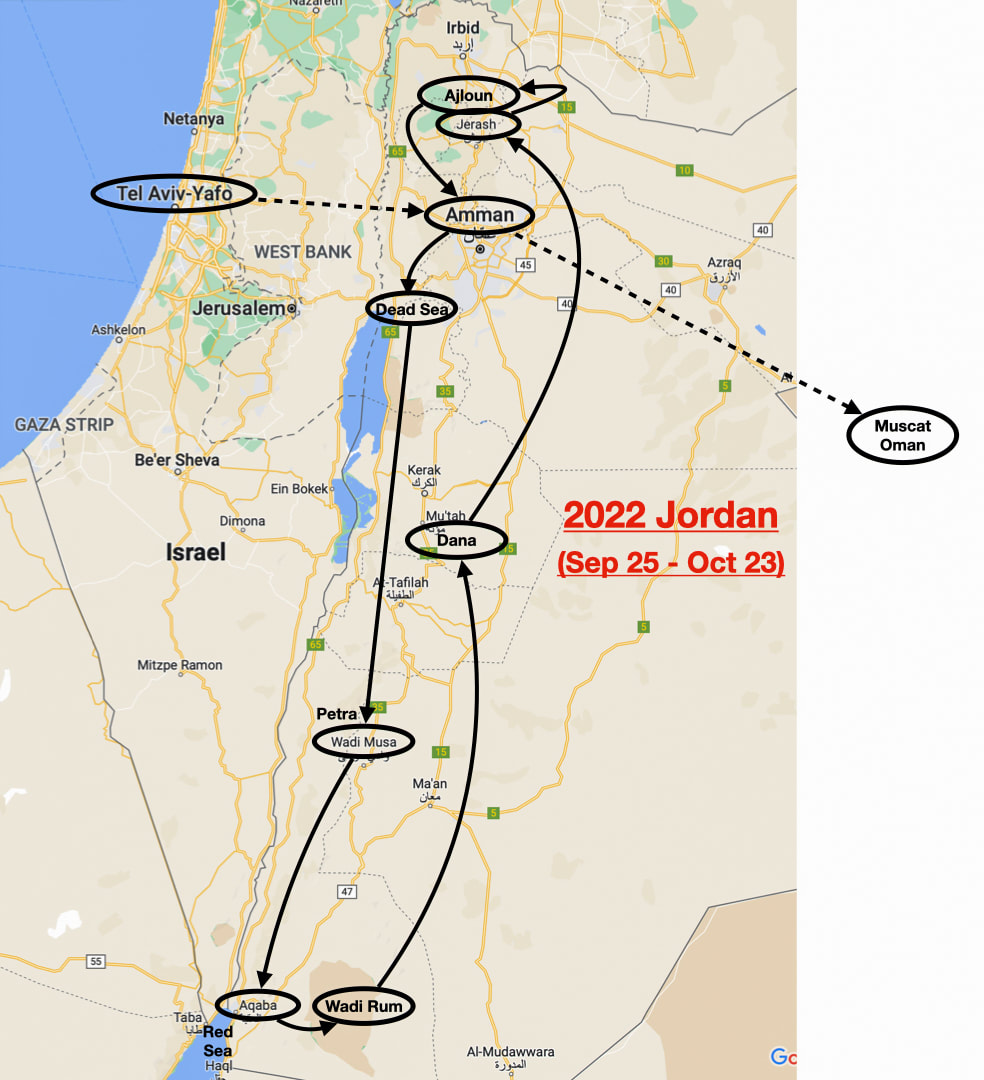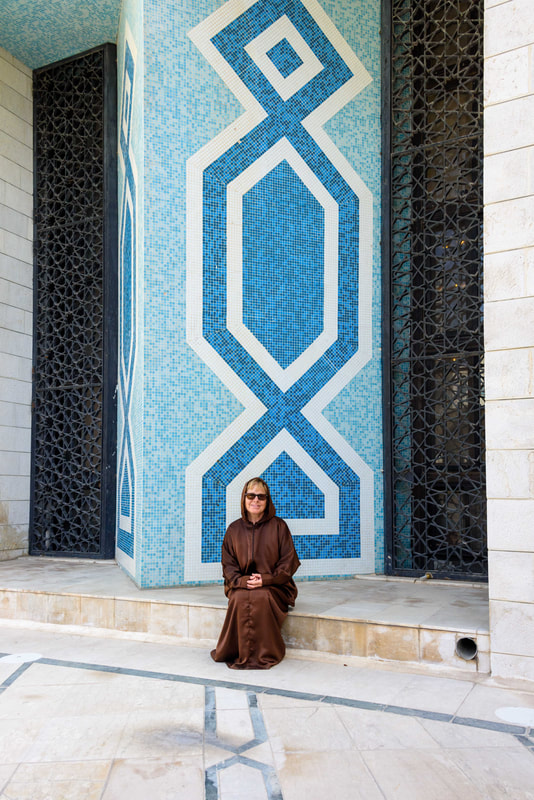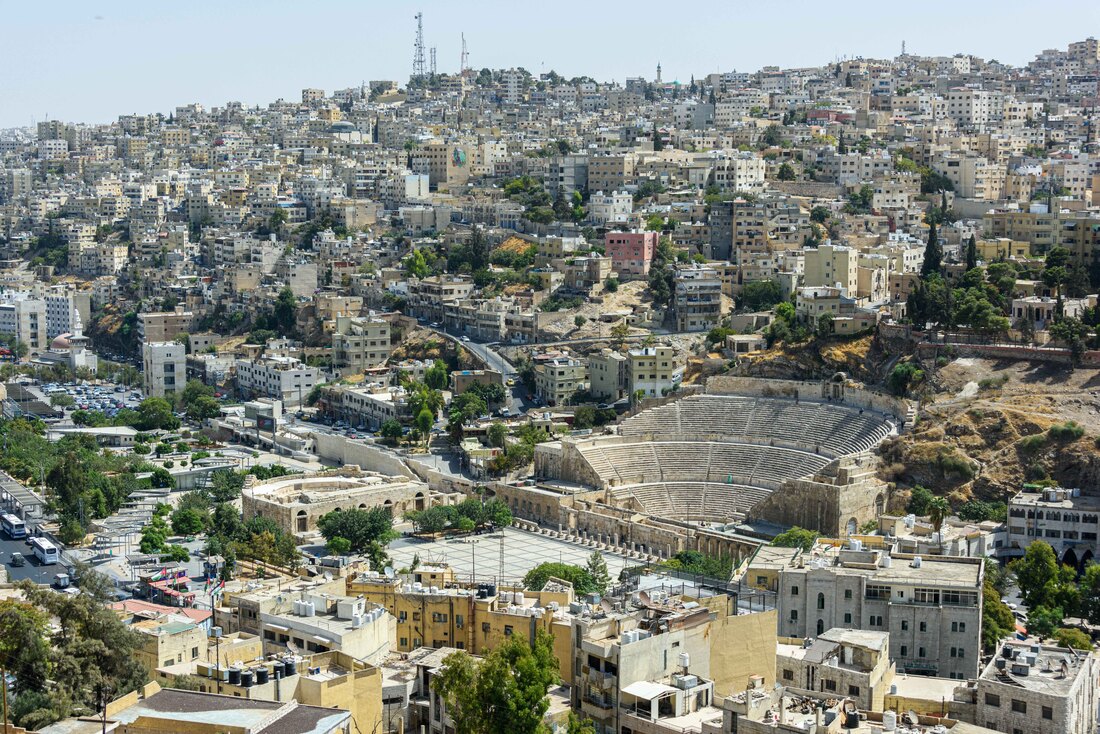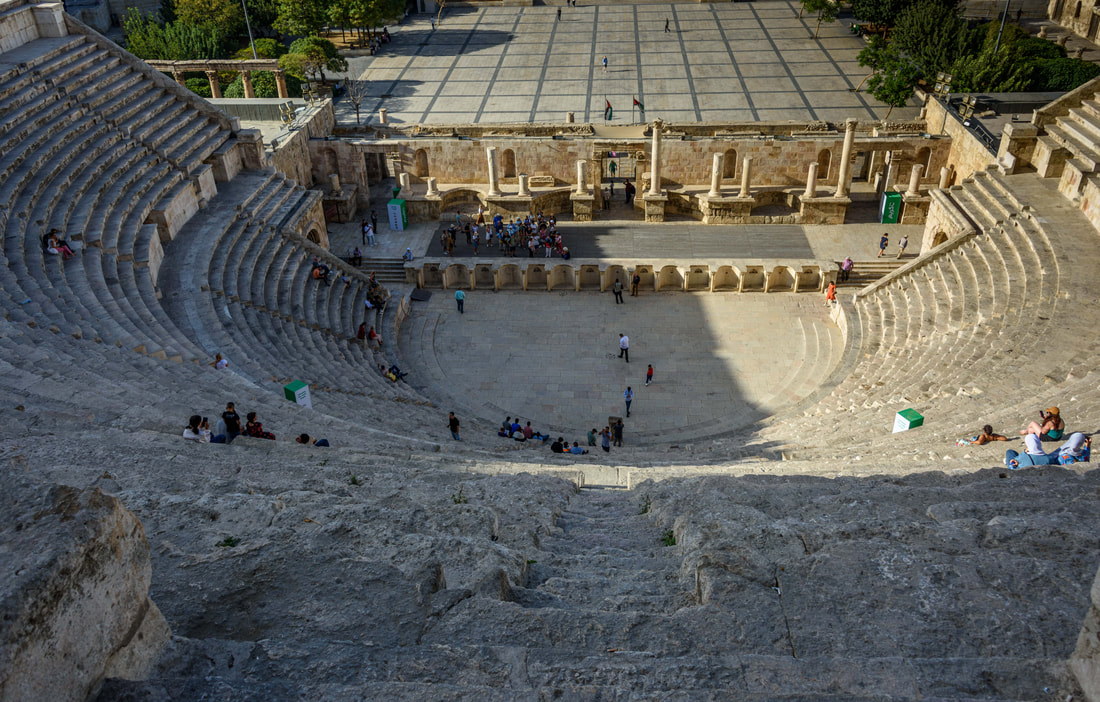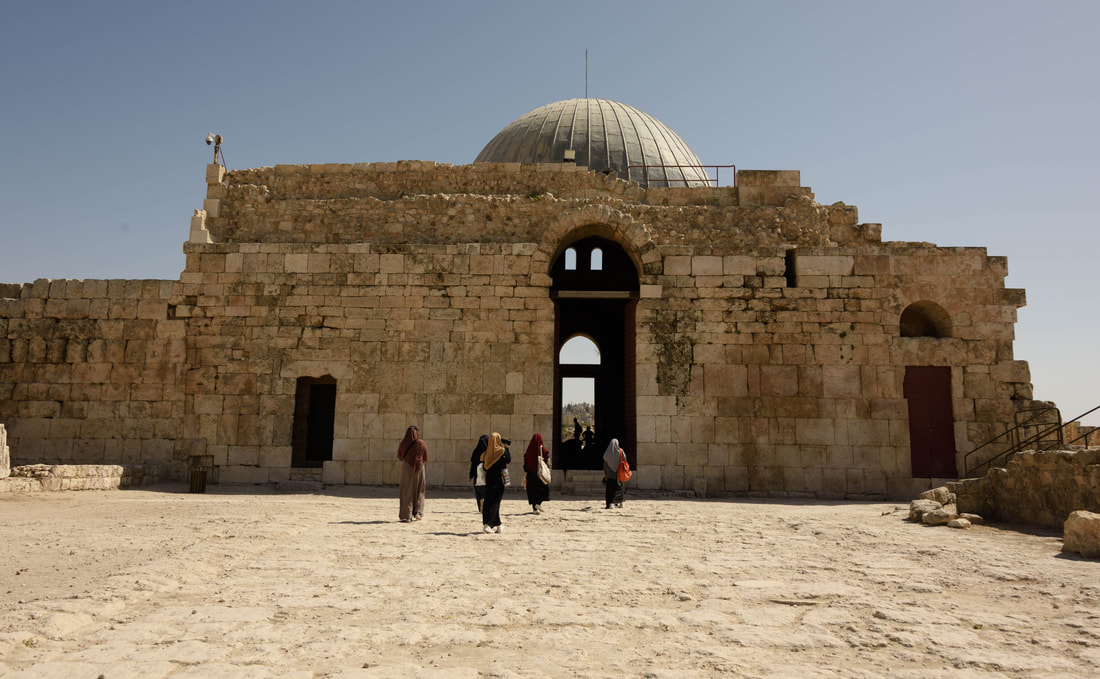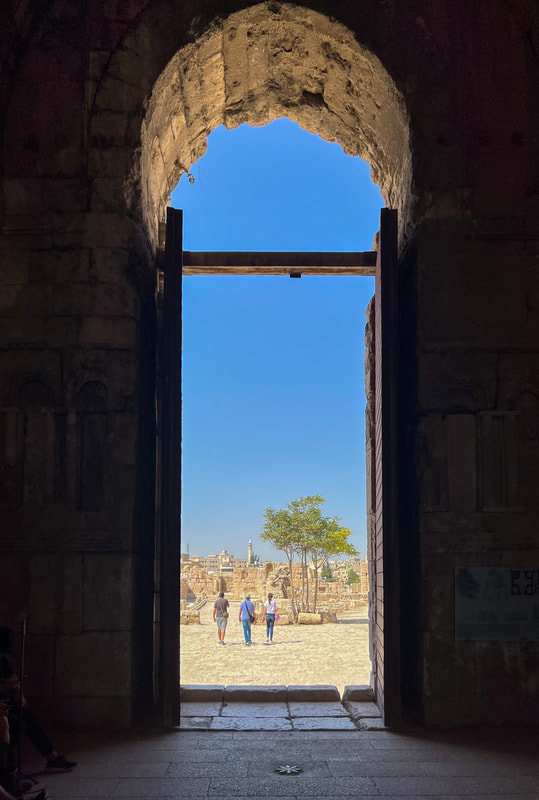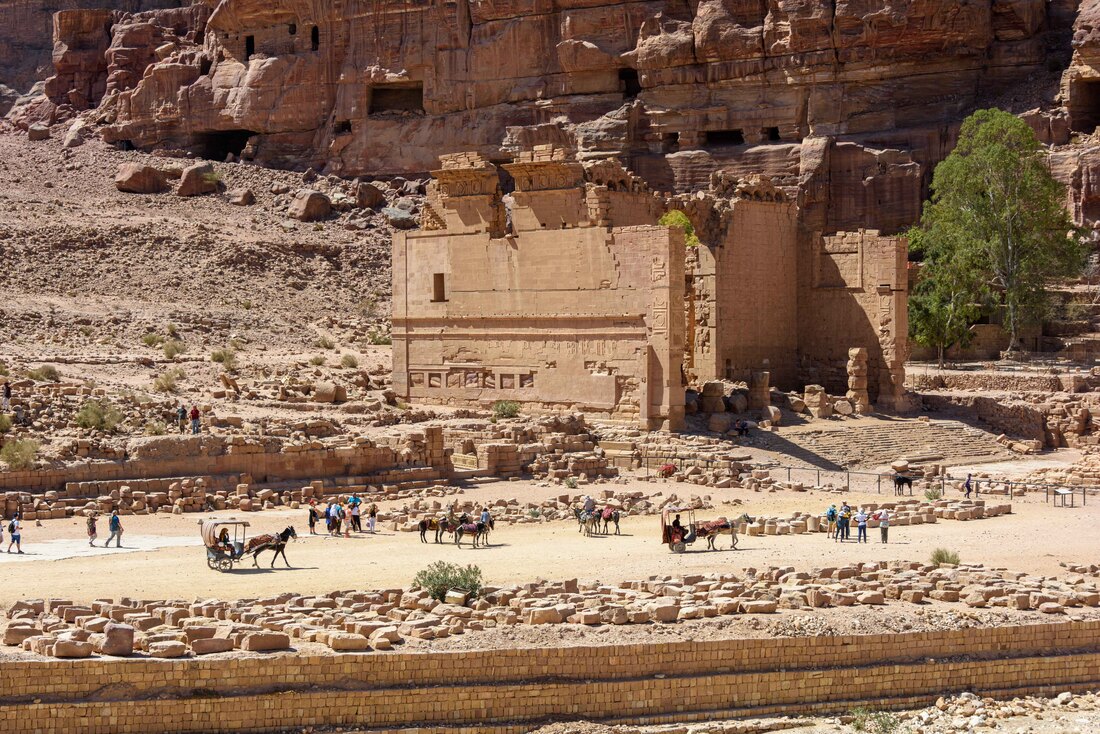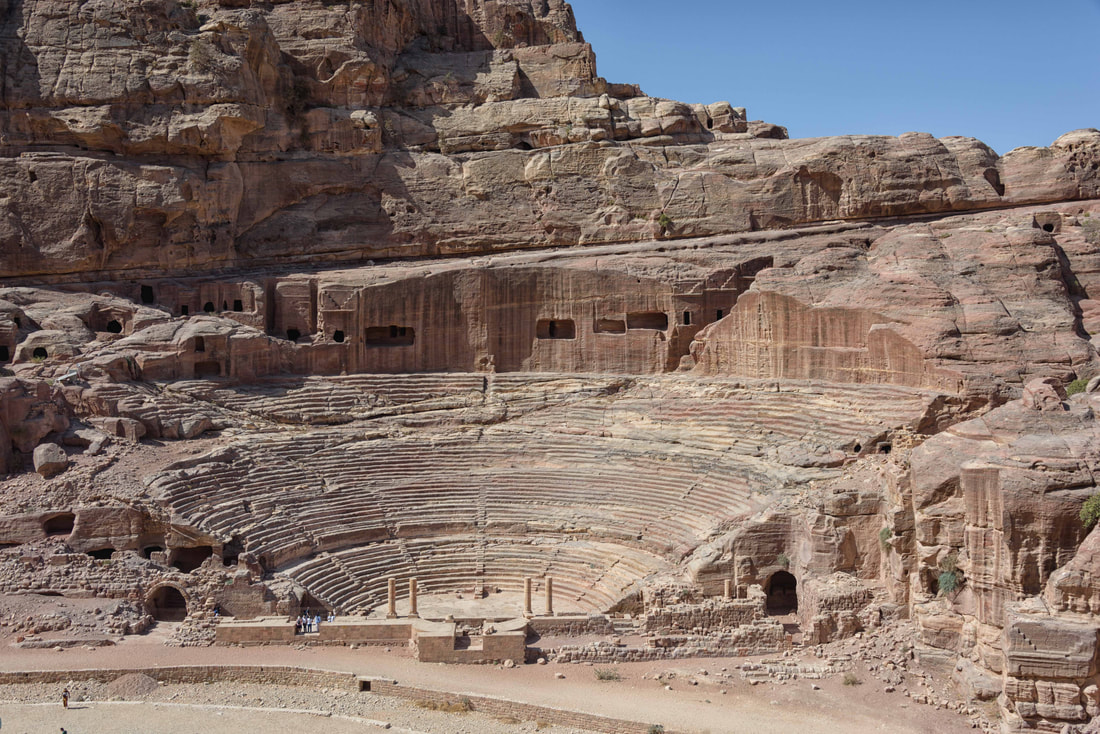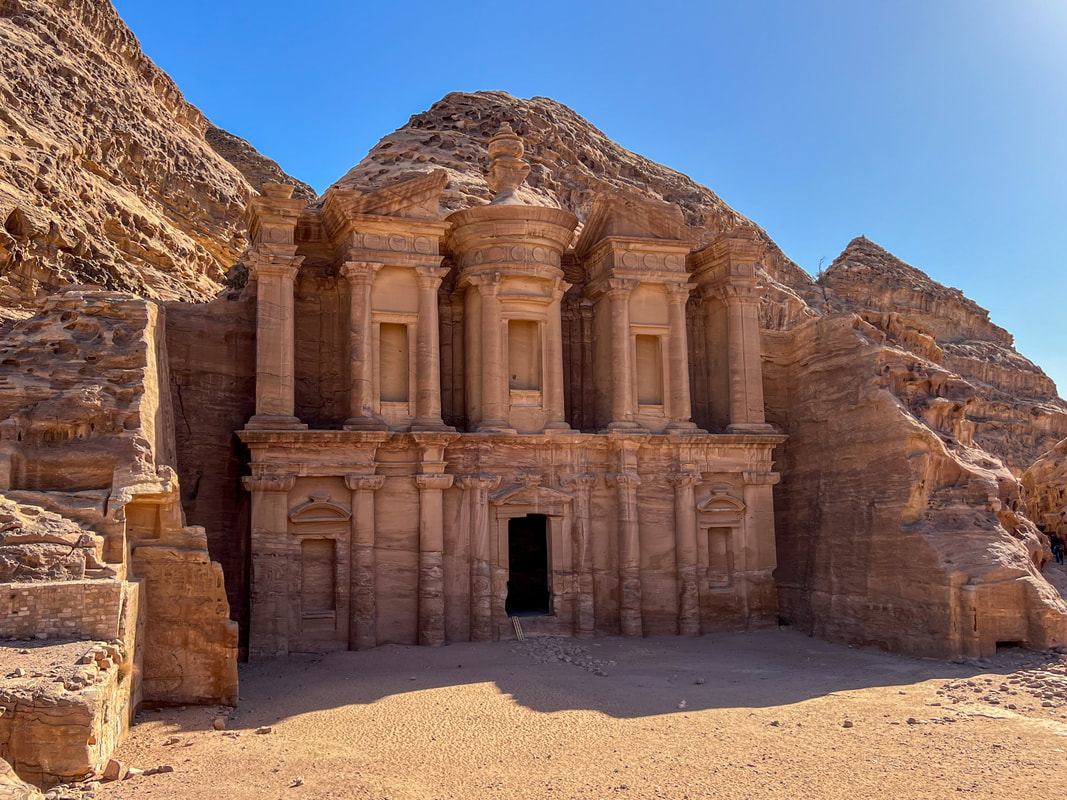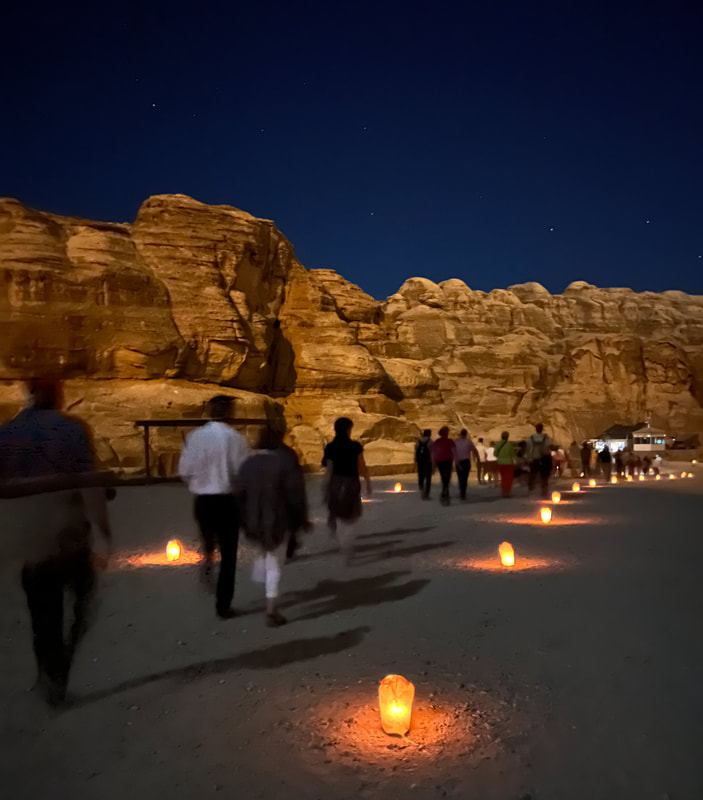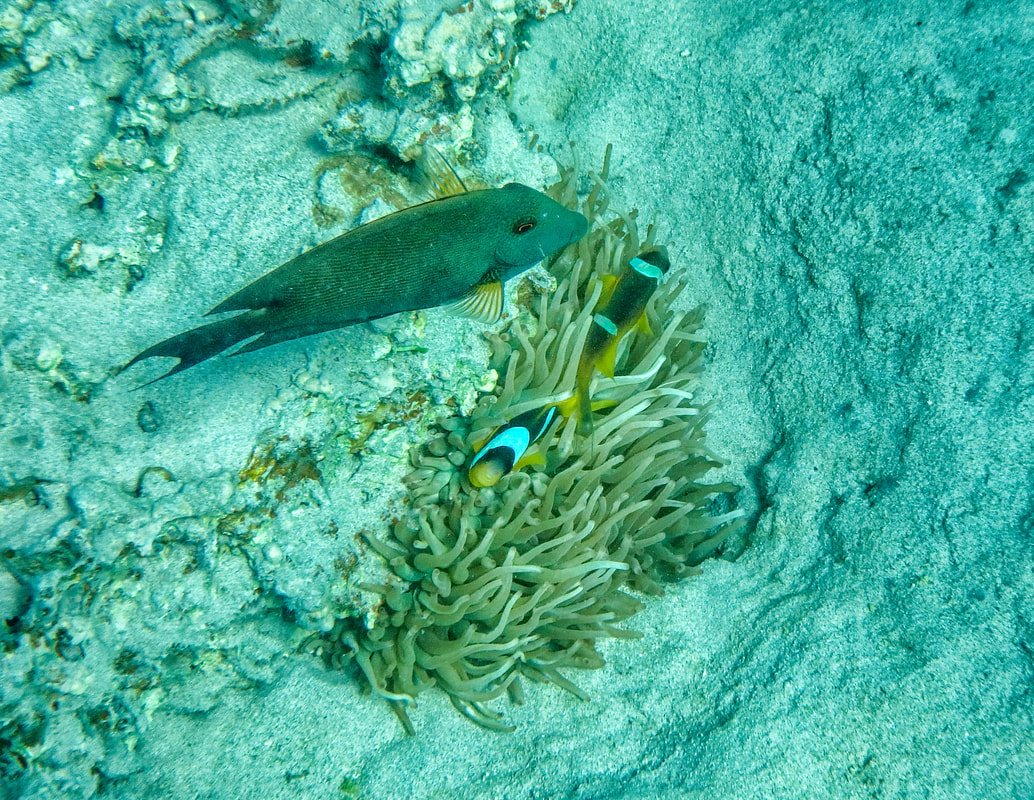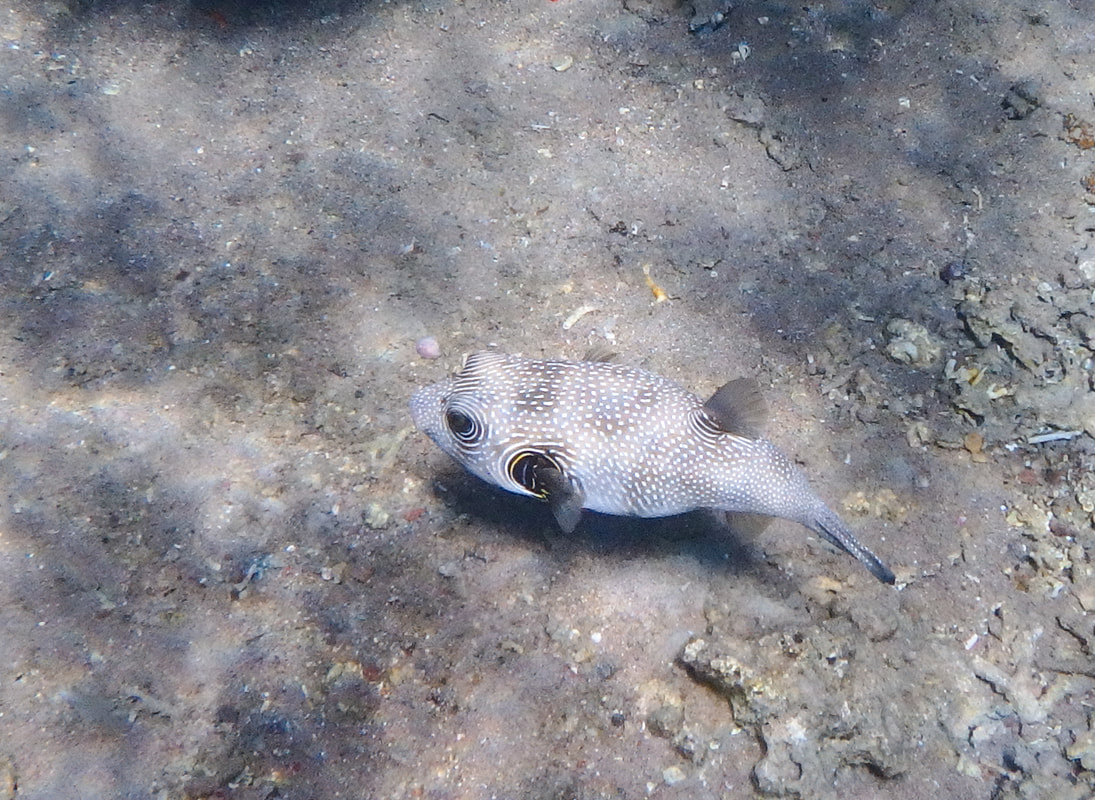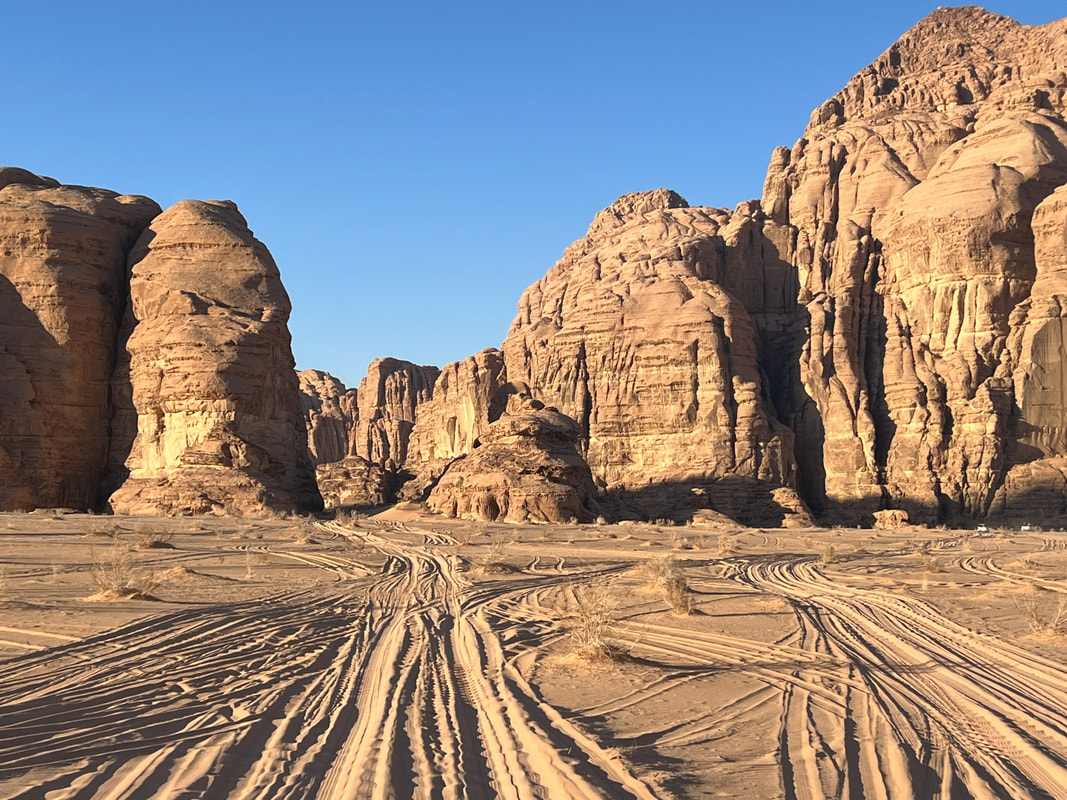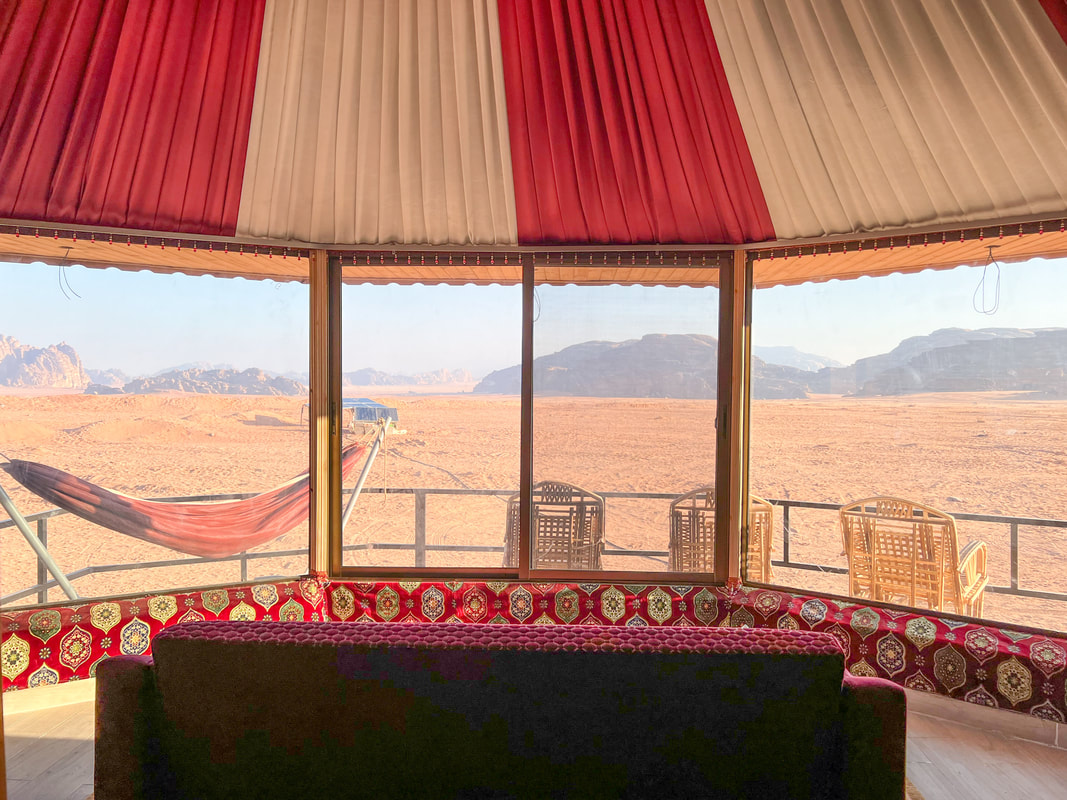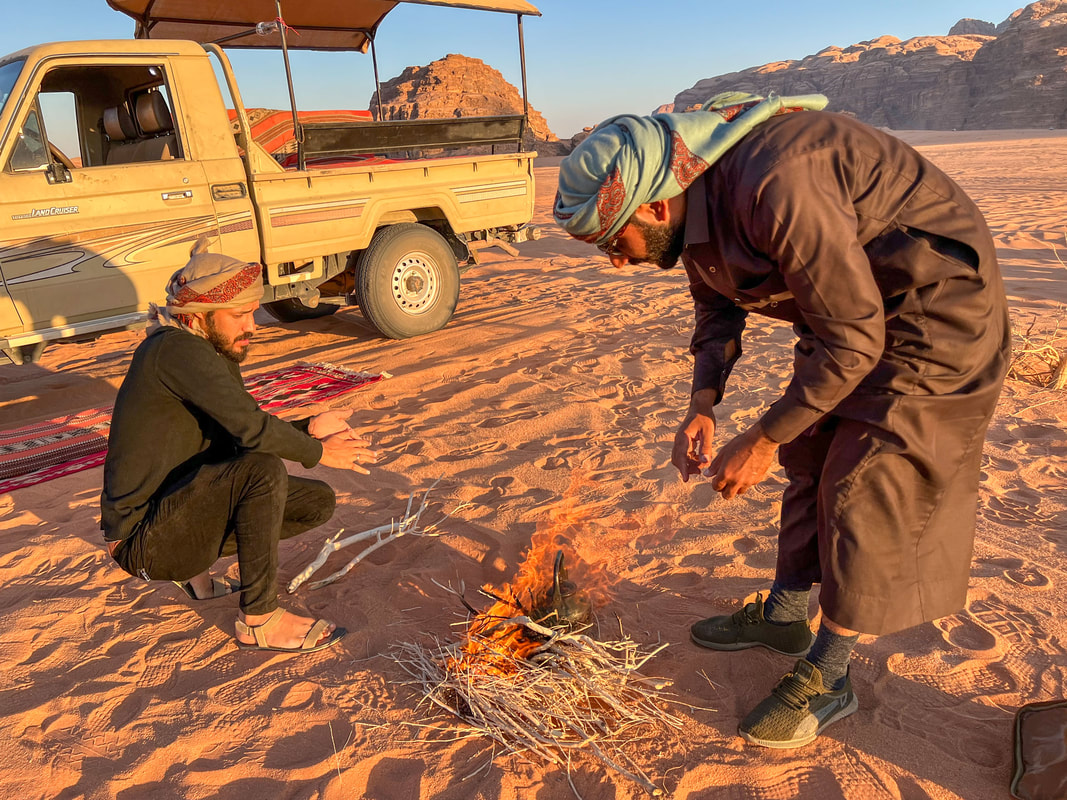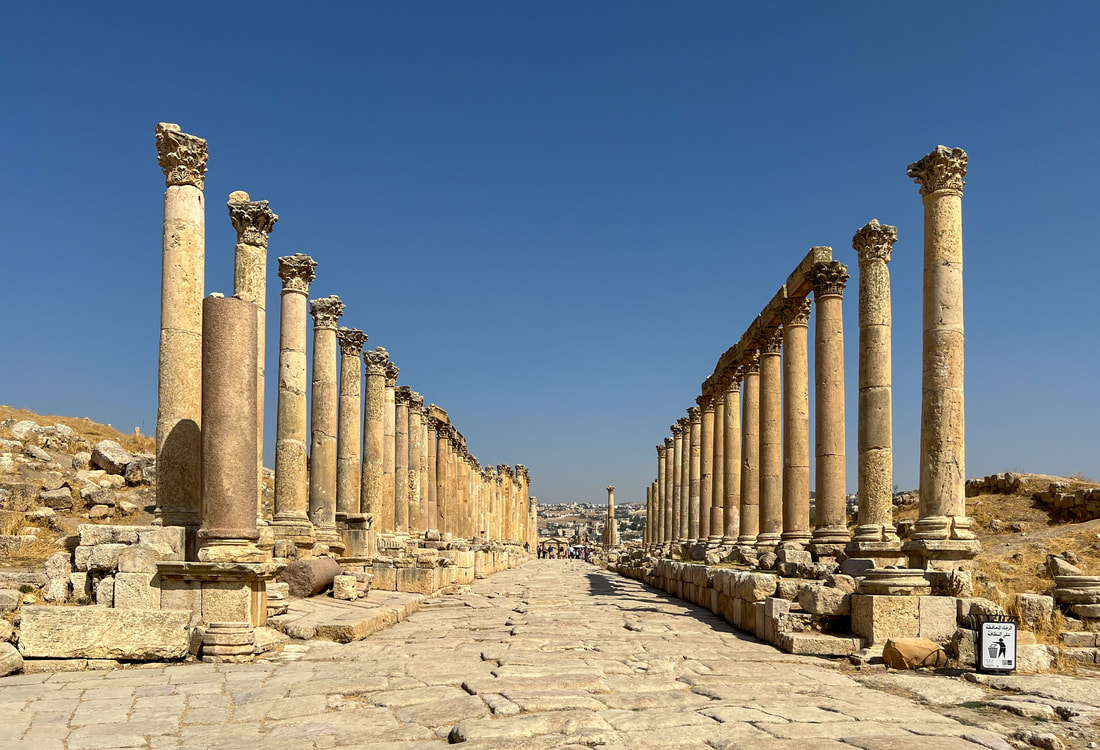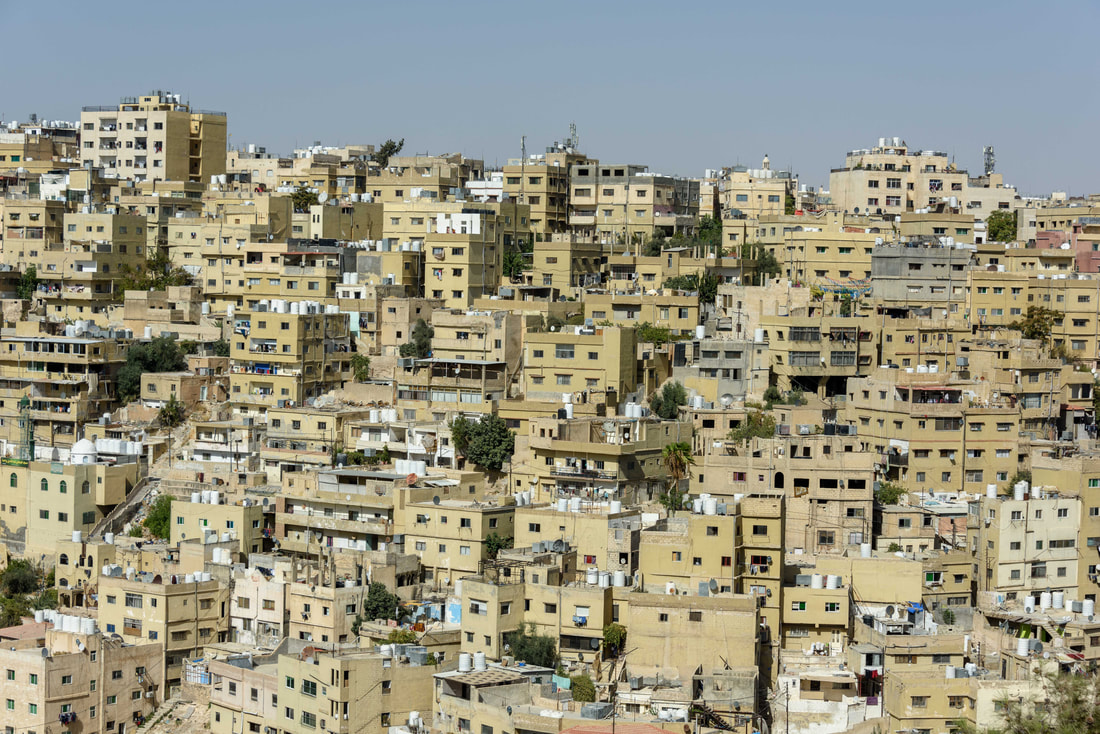
Jordan's capital is often referred to as the white city for its apartment buildings and houses that are made from limestone. Their homogeneous rectangular style gave the hillsides the look of terraced Lego blocks. At sunset we'd sip a cup of tea while looking out at our view of one of the hills. When evening lights were turned on the effect was whimsical, like an expanse of lanterns. (Amman, Sept 25-28)
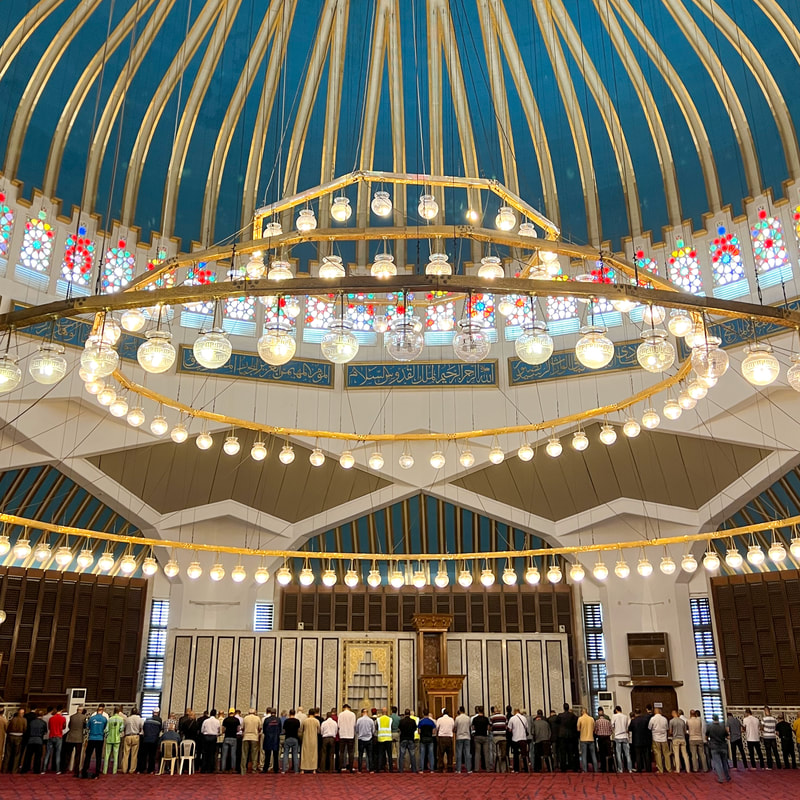
The stunning King Abdullah Mosque can hold up to 7,000 worshippers. Rick and I stood back as prayer was called and last minute stragglers quickly removed their shoes to hustle inside and fall into place. Nine-two percent of Jordanians are Muslim and their day is regulated by the muezzin, the man whos voice blares from loudspeakers at the top of the minarets or elsewhere. His position is an important one and he's chosen not just for his voice but also his good character. When he's not calling for the 5 daily prayers he keeps the mosque clean.
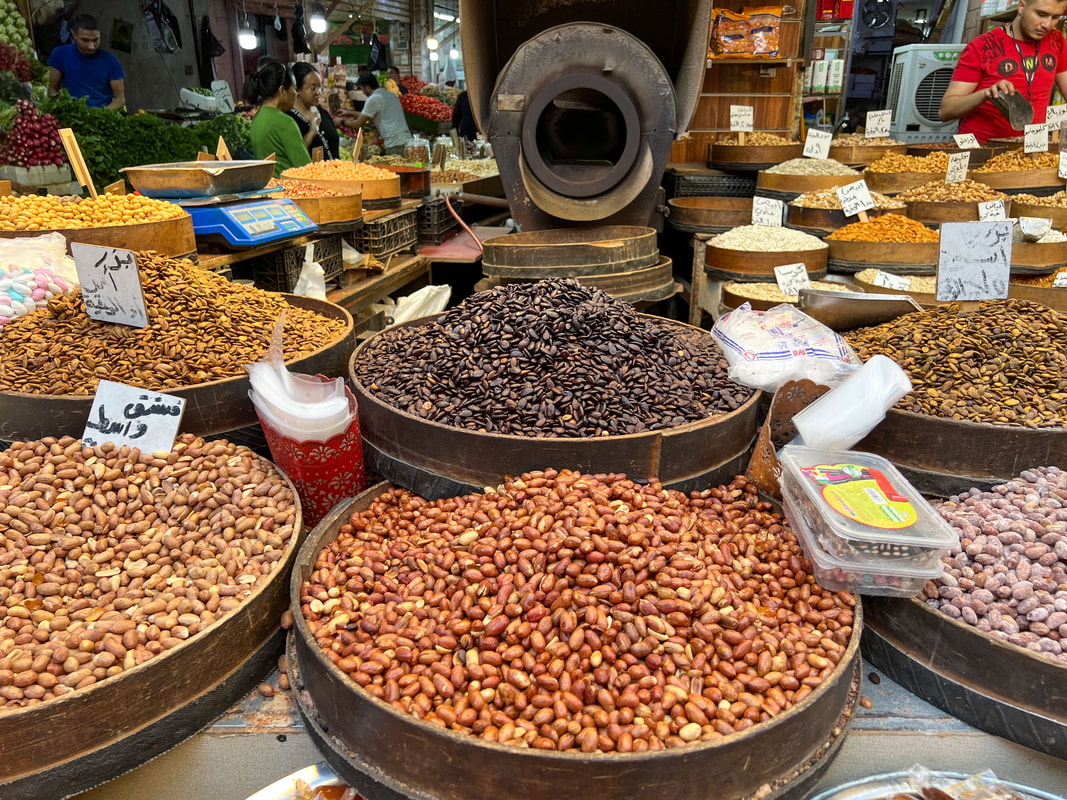
Next door to the theater were souqs for cookery, gold, fruit, nuts, sweets, spices, and incongruously lingerie, giving the sense that time has changed little in this part of town. The locals doing their shopping far outweighed the tourists and the merchants called out their goods to all walking by. The smell of freshly roasted nuts, straight from the roaster (background) was irresistible. After often eating huge lunches, a simple dinner of rice with nuts could sometimes suffice - a flavour combo we acquired a taste for in Vietnam.
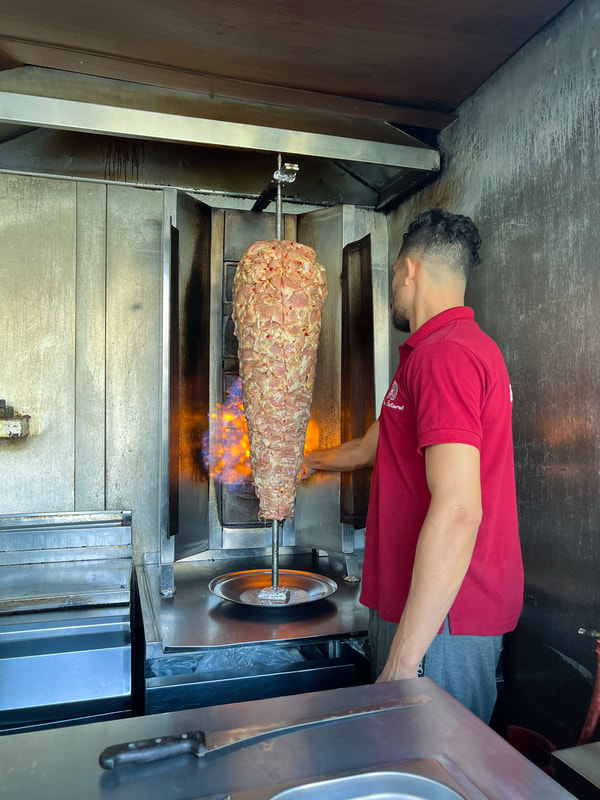
Having breakfast in a cafe one morning, the shawarma freshly wrapped in saran was delivered. The cook told us it consisted of 60 spiced and ready to grill chickens. This popular and tasty street food needs constant attention, manually rotated for even cooking. As customers buy shavings from the outer layer, the next layer has a chance to cook. Its surprising how juicy the meat tastes even as it's bulk is whittled down.
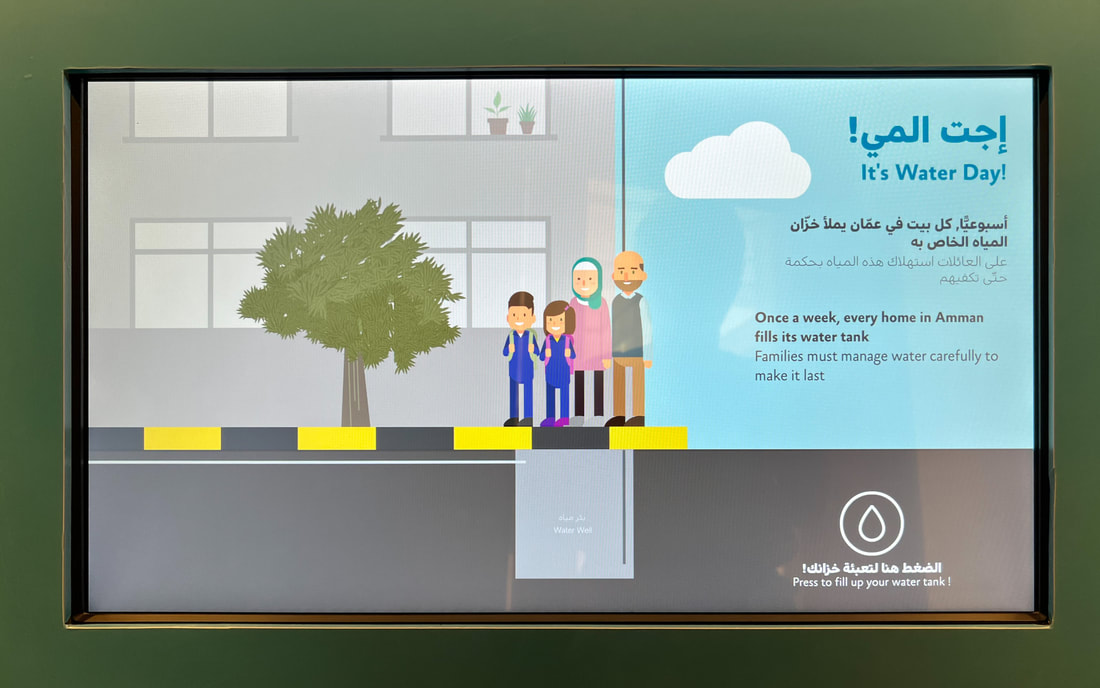
The capital has a world-class museum. A whole section was dedicated to water, something Jordan has very little of. It’s the fifth most water impoverished country in the world and continues to consume more than it has access to. Here, as in many other water-challenged countries, our showers are quick, and taps don’t run unnecessarily.
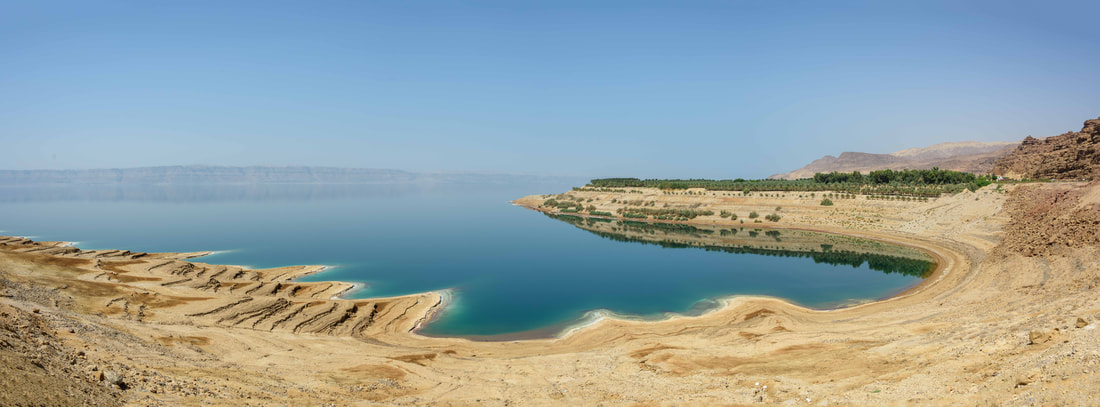
The one hour drive from Amman to the Dead Sea moved through a desolate and arid landscape punctuated by the occasional herd of sheep and goats with their shepherds. With almost no vegetation, it was hard to imagine anything but a hard-scrabble existence for livestock. The sea is 50 km long and 15 km wide and sadly is receding by about 1m per year. (Dead Sea, Sept 30-Oct 2)
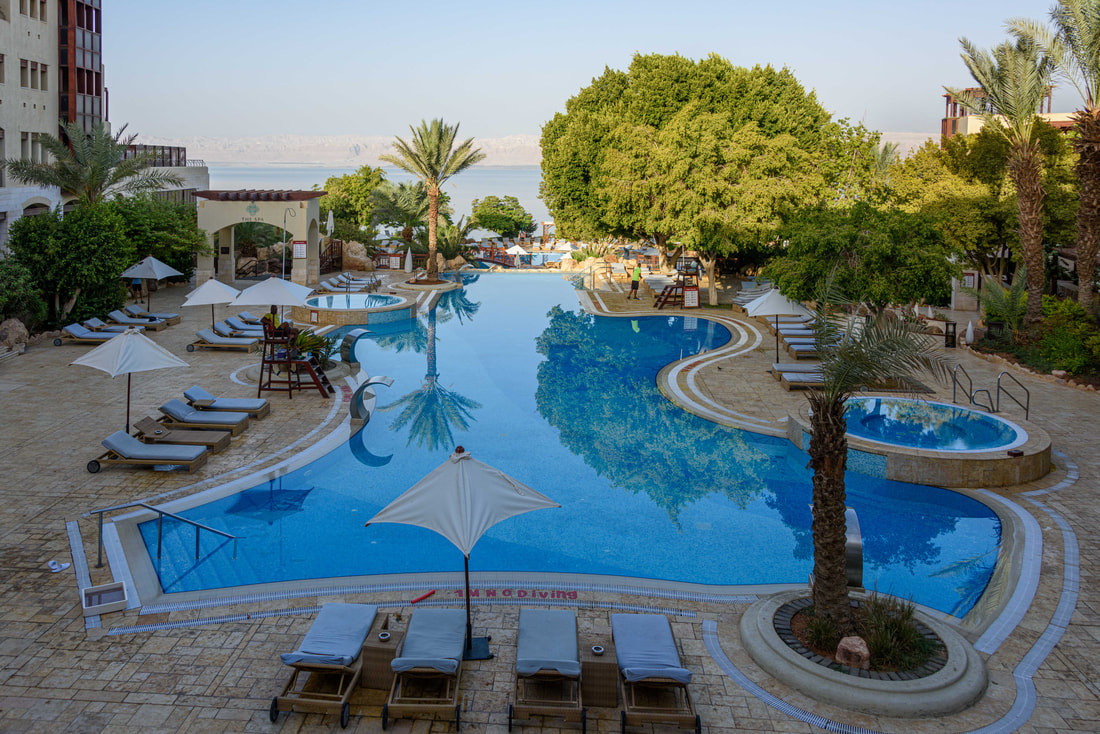
To a large degree, the Dead Sea experience is limited to those that can afford the upscale resorts. There are only 9 of them on Jordan's side of the sea and there are no mid or low range hotels. Although the elitism of it is unfortunate it is saving the sea from over tourism. It is already challenged by evaporation and use in producing potash, one of Jordan's most valuable exports.
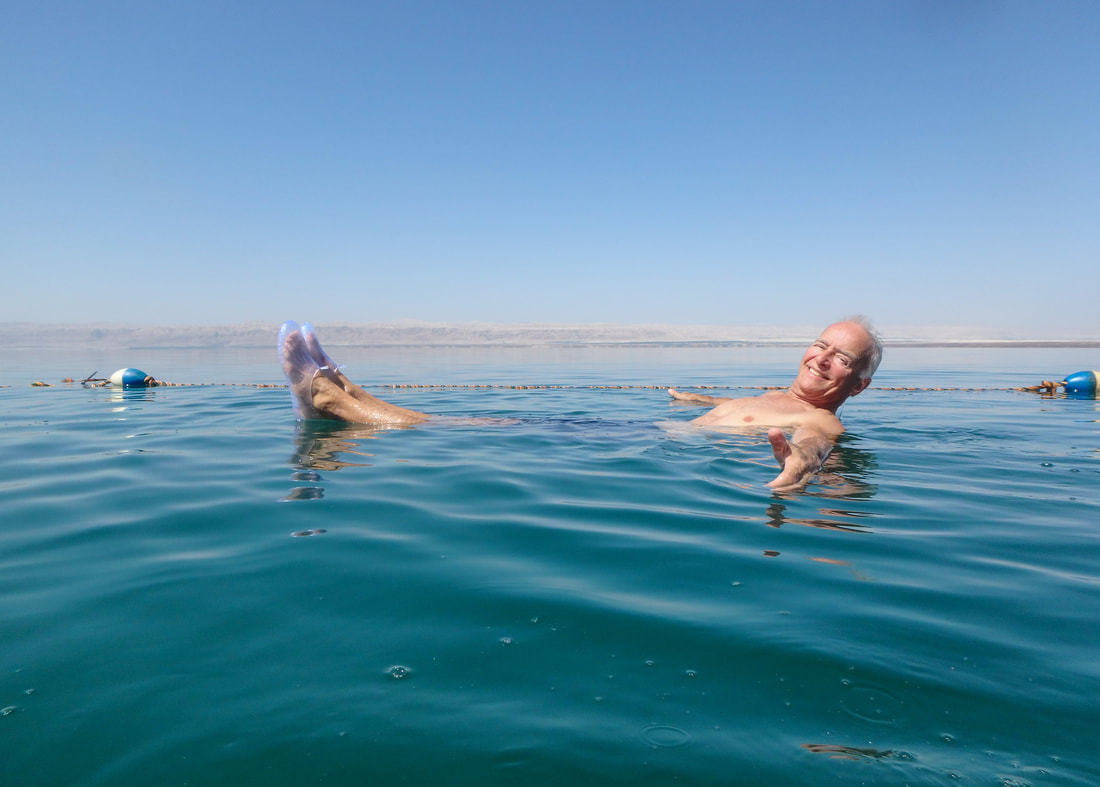
The iconic shot of effortlessly floating in the Dead Sea. You had to be careful not to put your feet even a little bit down and back otherwise you'd topple face forward into the hyper-saline water and it was painful if you got even a drop in your eyes. The high density of salt - 9 times that of the ocean - created quite an oily feel and appearance in the water. It was so pronounced at first I thought it was sunscreen, but everything I read pointed only to the salinity.
The plastic booties were to protect your feet from the sharp rocks when entering the water.
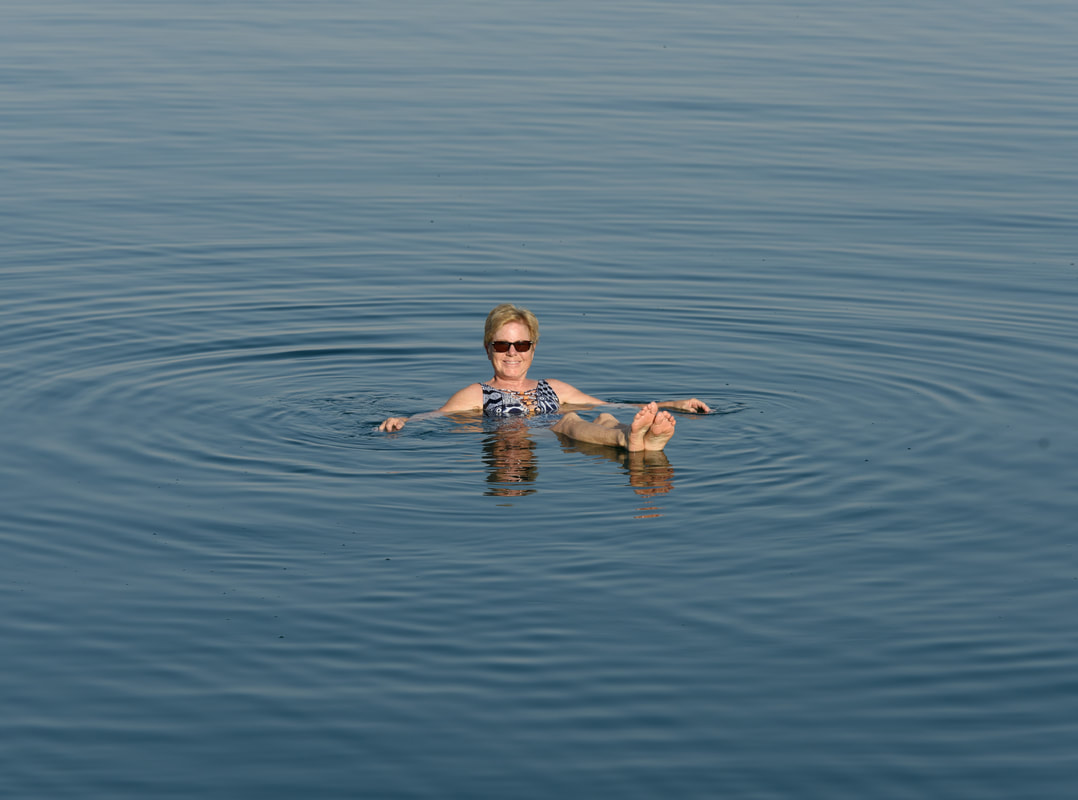
It's been over a month of wearing long skirts and an abaya. It felt freeing to not have my skin covered. After an afternoon float, I had a Dead Sea Mud facial. It was a relaxing indulgence and scrubbed away layer upon layer of sunscreen. The 2 days here definitely included more pampering than usual. A long-time employee told us that many Jordanian families come here annually and that they feel like family. It was good to know that it wasn't just for the tourists.
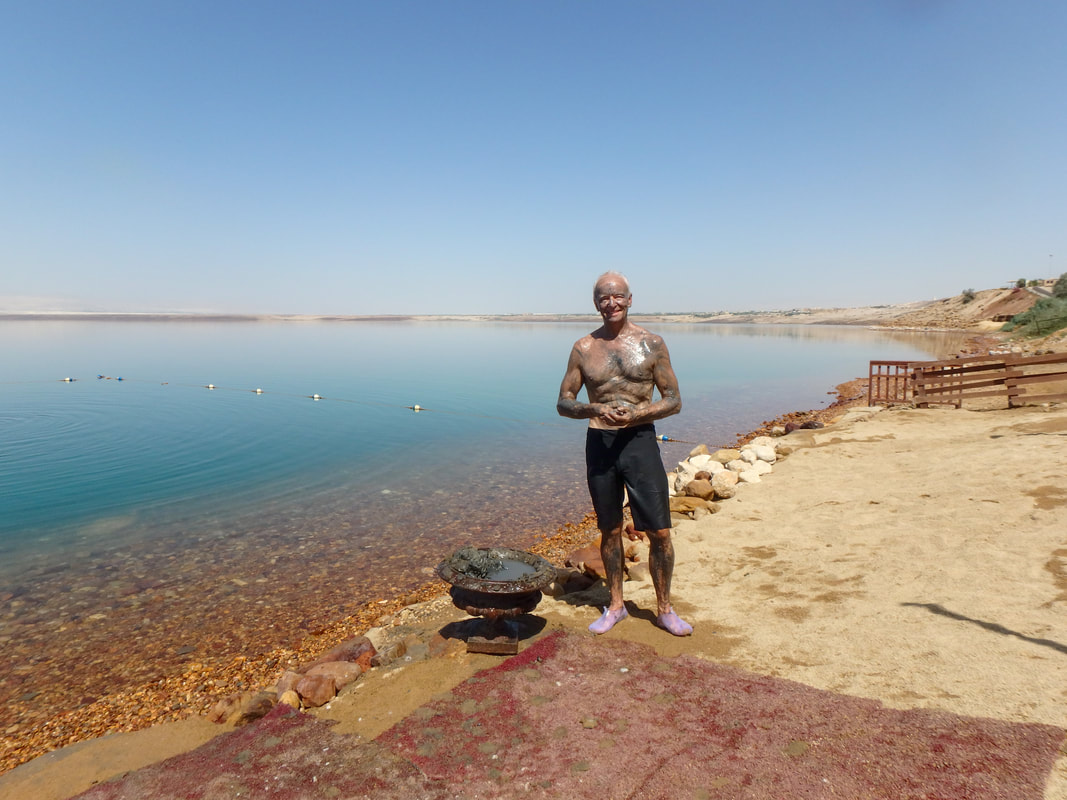
A couple of pots of mud were on hand for a DIY mud pack. The sea’s attributes are being recognized for their legitimate healing properties (ie because it’s 420m below sea level, UV rays are partially blocked by the increased thickness of the atmosphere, allowing those with psoriasis to benefit from sunbathing for long periods). And it’s a good thing the UV was partially blocked because the two days we were there it was 38 and 39°. Stepping into the 28° pool felt chilly.
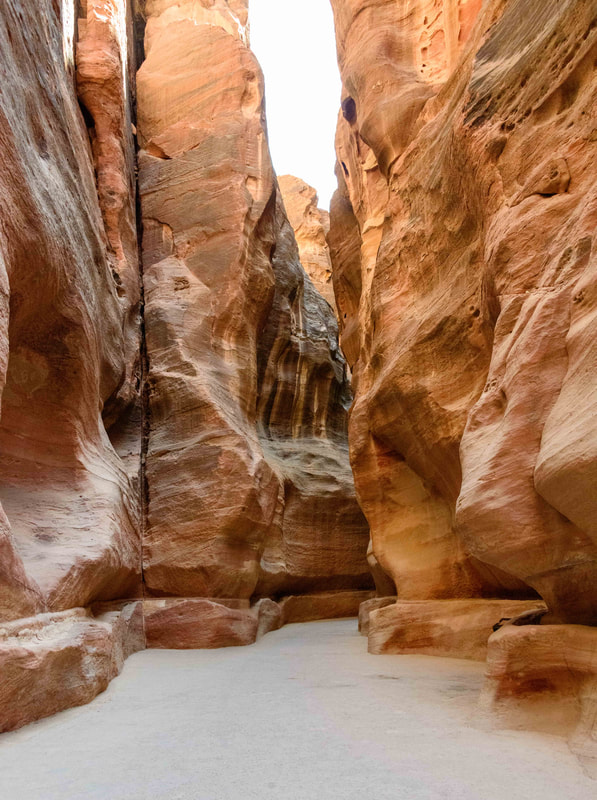
Caused by a shift in tectonic plates, the stone here was pulled apart creating the siq. This narrow passage extended for over a kilometer. There was a feeling of anticipation that built up as we turned each corner and then at the end saw a slice of Petra’s star attraction, The Treasury. And hours later, hot and tired, it provided shade and a quiet time to reflect on the day’s events and sights. That daily walk was a highlight. (Petra, Oct 1-6/22)
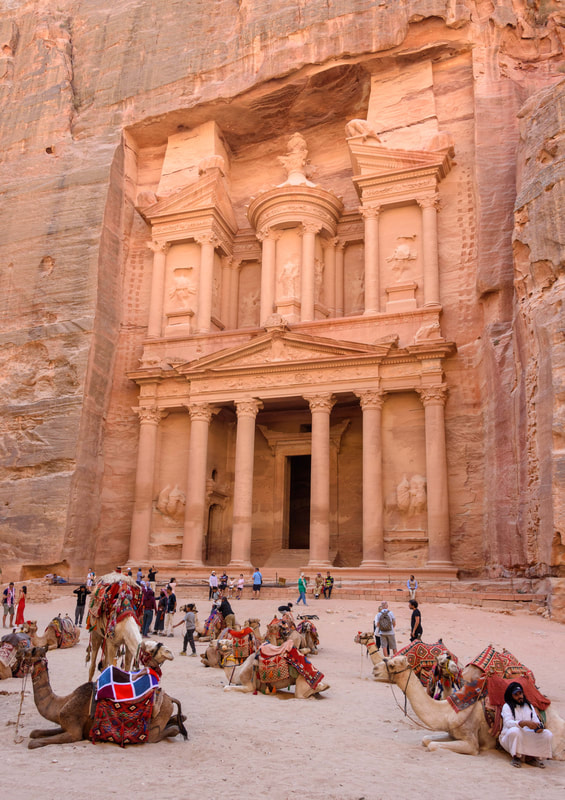
The Treasury – we were advised to come early to beat the crowds for our first sighting of this iconic structure. Petra is one of the most famous archaeological sites in the world and on a scale we’d never seen before. After 3 full days of walking and hiking, and for Rick a fourth, we still had not seen everything. It was tough to decide which pictures to include and they won’t do justice to the awestruck feeling of walking past tombs and temples the size of high-rises.
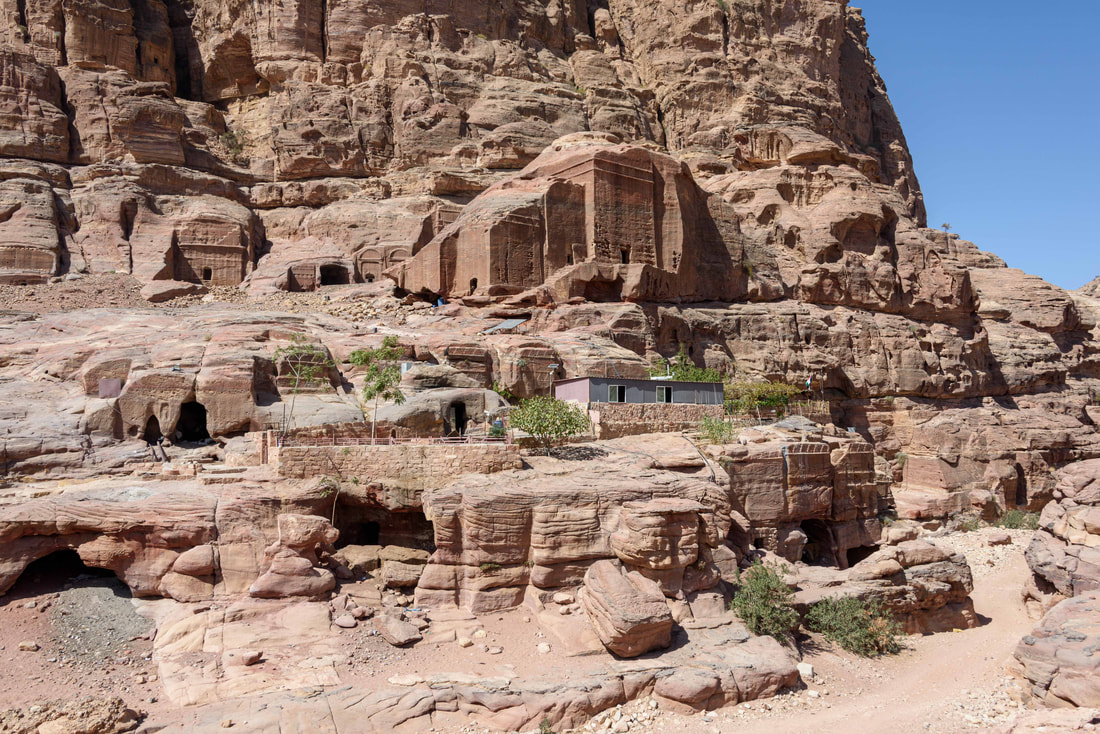
Most of the tombs and temples - intricate facades carved out of the sandstone rock - were created in the 1st century BCE by the Nabataeans. How they did it remains much a mystery. For 5 centuries it thrived as part of a trade route for frankincense and spices until it was replaced by the Silk Road trade route.
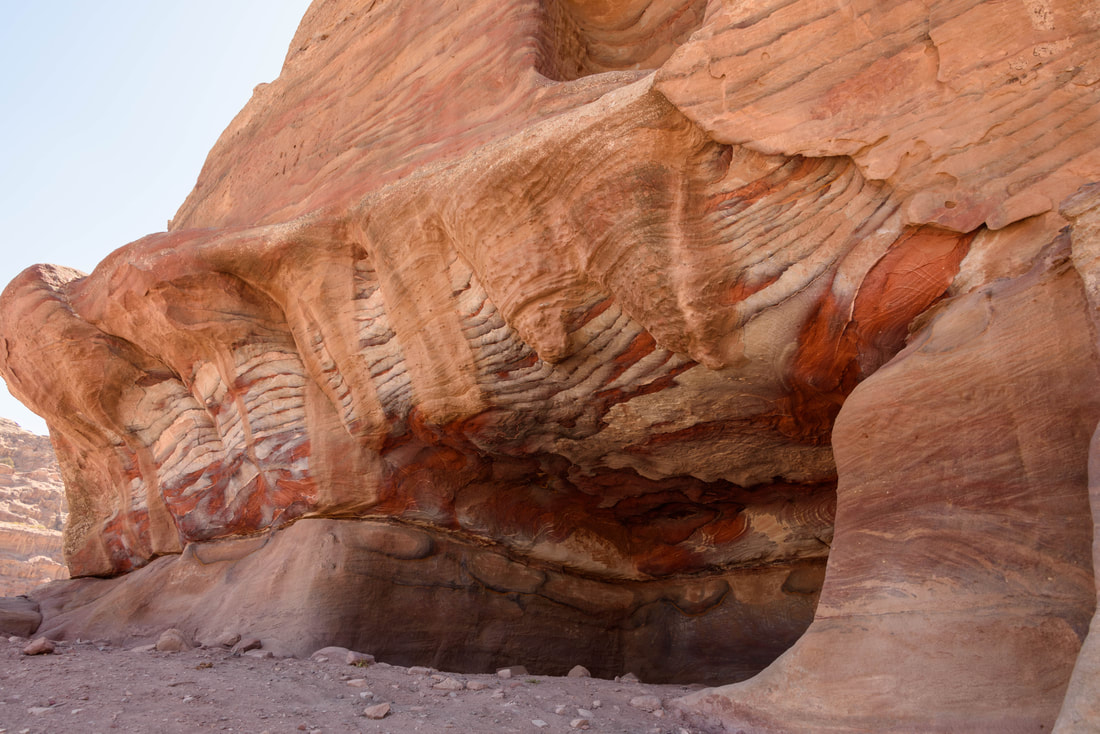
For the following 13 centuries it remained intact and largely deserted except for some Bedouins who called it home and closely guarded its whereabouts. Then, like a page out of an adventure novel, it was rediscovered in 1812 when an intrepid Swiss explorer disguised himself as an Arabic religious pilgrim and convinced a Bedouin to show him where this amazing religious site was. Above: some of the caves and structures had gorgeous natural colours.
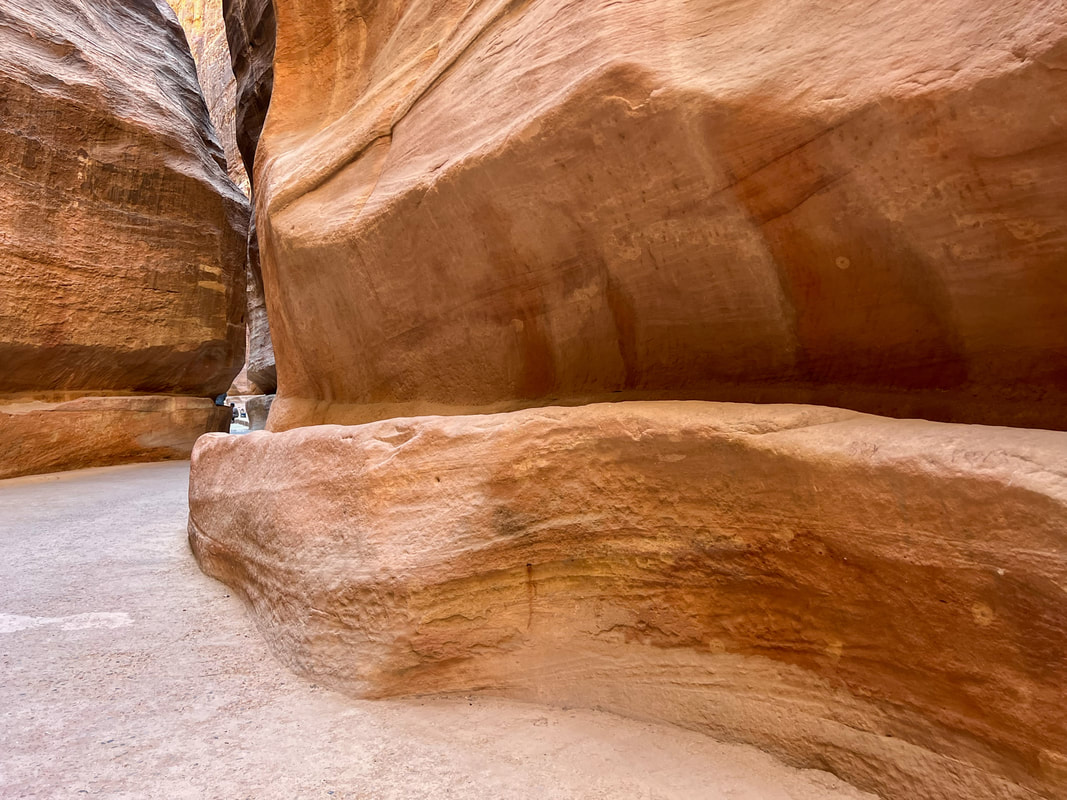
The Nabataeans were masters at managing water. Channels carved into the rock and thousands of terra cotta pipes fed cisterns and those in turn purified the water and created pressure for further delivery. Many of the structures are in use today. Historians are baffled as to how their mastery of water could have been achieved with the limited mathematics at the time. However, Petra served as a main stopping point on a major trade route, so they would have benefited from the knowledge shared by international travelers.
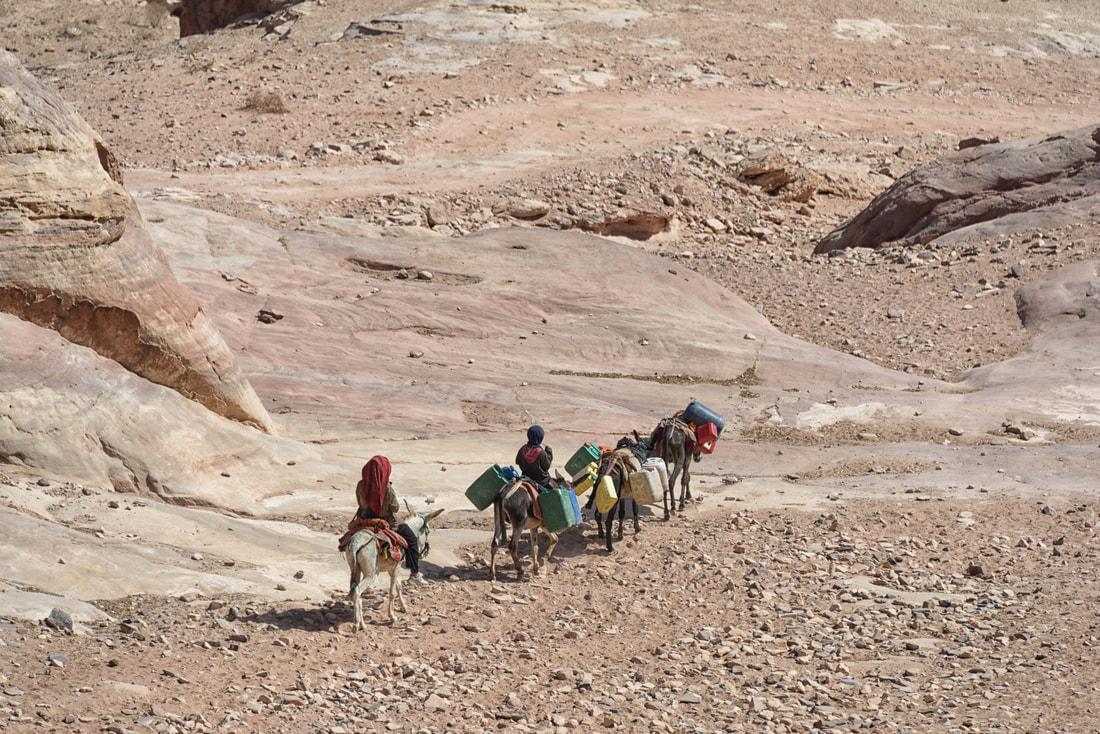
When it became a world heritage site in 1985, the Bedouins were relocated to government built homes a little way up the valley (yes, a familiar story). But today, about 35-50 families continue to live in the caves on the outskirst of the site. It’s illegal, but appears to be tolerated as water has been piped in for them to pick up at a central point (above). A local Bedouin told us that hardly anyone walks the path marked on the tourist map as it’s out of the way. His mother still lived in one of the caves and he encouraged us to check it out. We certainly stood out as several women and a couple of men called out to us to come in for tea. One time, a woman called from the top of a hill (a good 500m away) to come in for tea. When we realized she was actually calling for us, we yelled no thank-you. Seeing that we were continuing to walk, her teenage daughter and small son ran down the hill with a hot pot and 2 cups to serve us roadside for the going price.
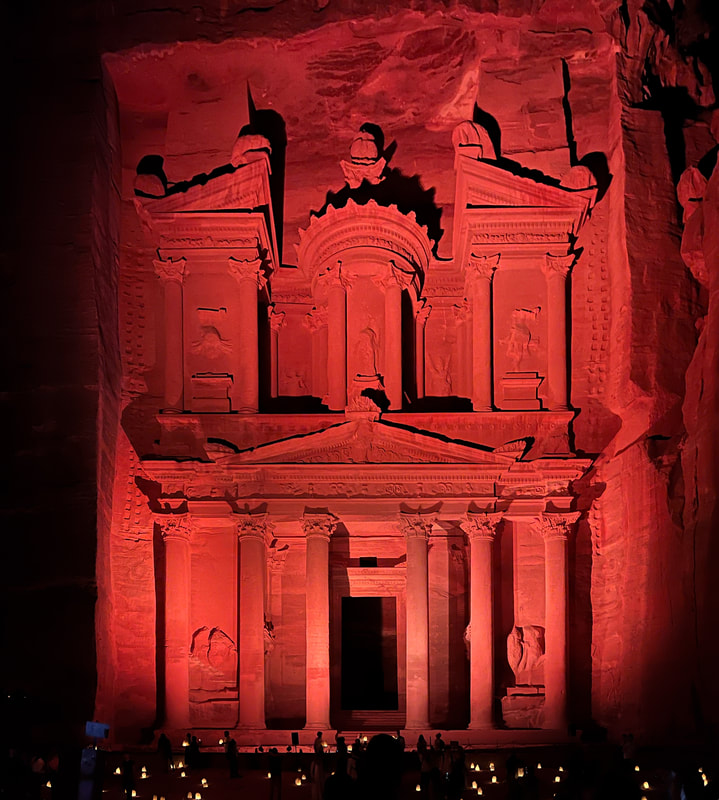
At the Treasury, candles dotted the ground and everyone sat on mats to face the highlight of Petra. Three performers alternated between playing the flute and a traditional guitar while various coloured lights lit up the sculptured tomb and the best mint tea we’d tasted was served to what looked to have been close to 1,000 participants. The evening was topped off with some high drama. While we were making our way out on the dim candlelit path we had to jump out of the way as a bedouin on horseback careened through. Seconds later he was on higher ground with a buddy exchanging obvious “what, us?” calls with the police in a van below. Then, the bedouins bolted, quickly chased by the police. We lost the group as they exited Petra’s entrance gate.
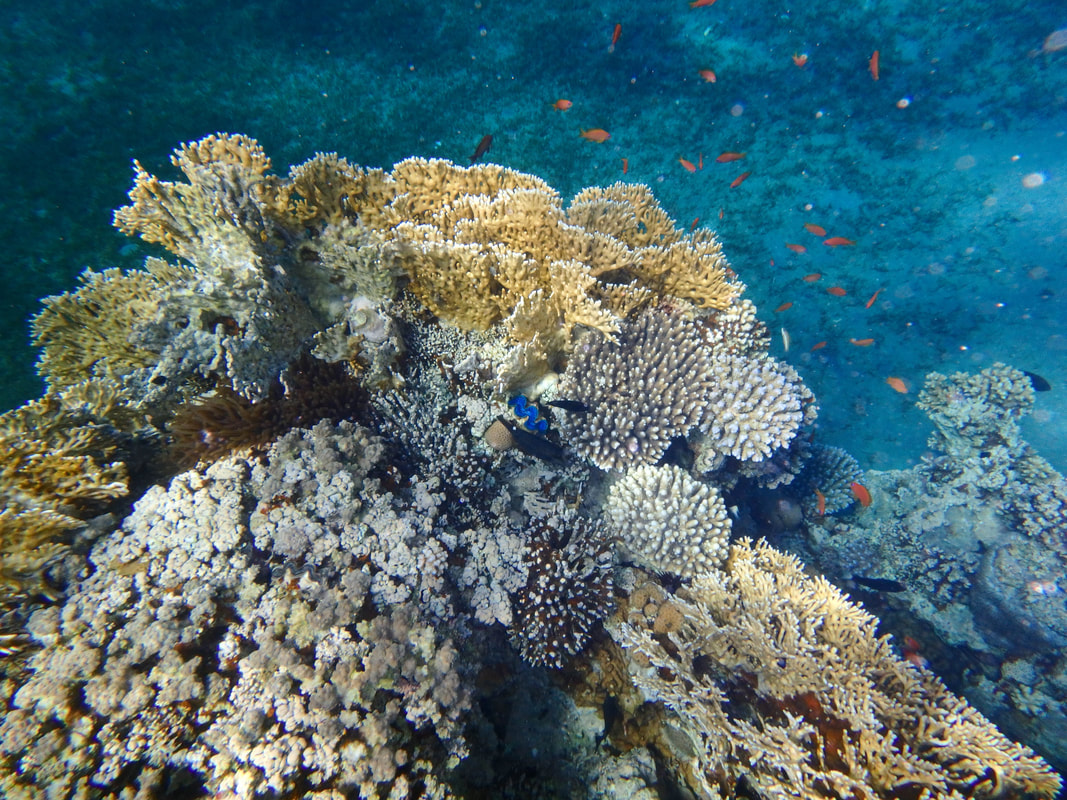
The snorkeling in the Red Sea surpassed expectations. Our old underwater camera didn’t do it justice, but the photos will jog our memories. So many fish, and all within easy access. The protected Aqaba Marine Park has 7km of reef and most is just 3-7m from the shoreline! It’s so dense you have to be careful you don’t drift too far, or you’ll have a challenging time finding the few reef-less bare spots that allow you to get back to shore. (Aqaba, Oct 7-12)
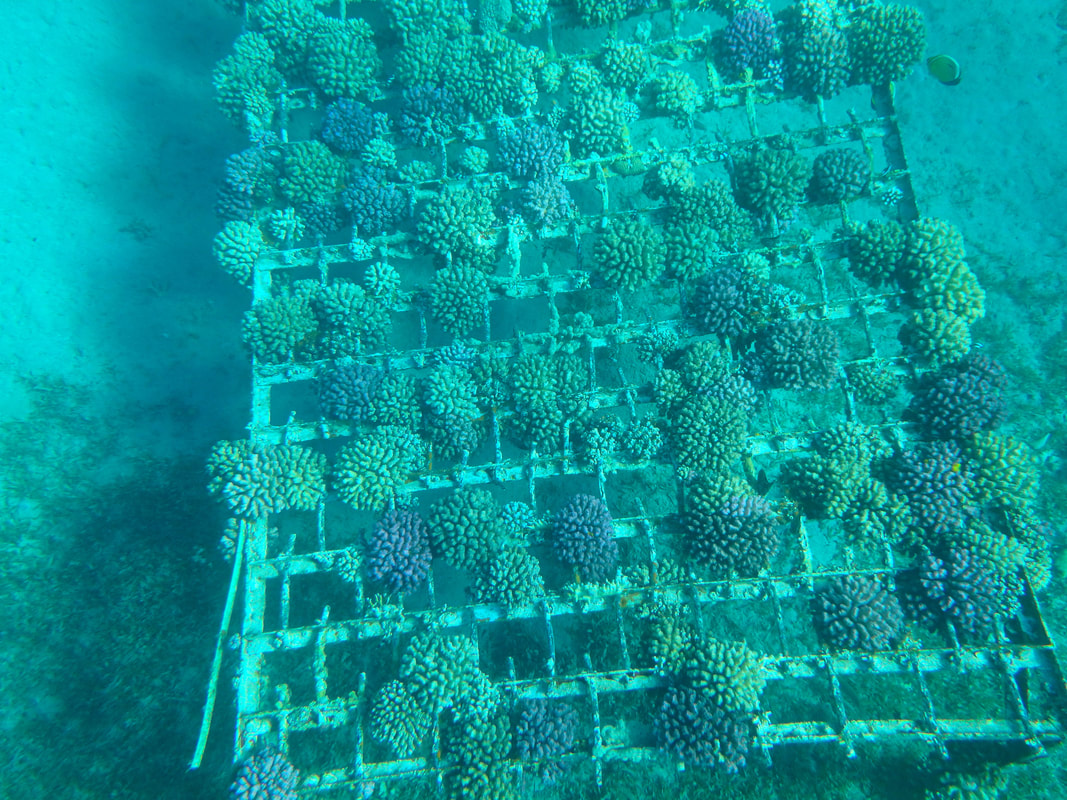
Our timing was fortuitous. In 2012, corals from 3km south (near border of Saudi Arabia) were carefully transported to their current location where the reef had been damaged. They were placed on various shaped metal structures, a submerged plane and a small ship. Divers even had an underwater military museum with battle objects for the coral to adhere to. The sites were closed to visitors until 2018 when researchers found that the transplants were surviving and regenerating at a rate of 85%, much better than the usual 60-65% with these types of efforts.
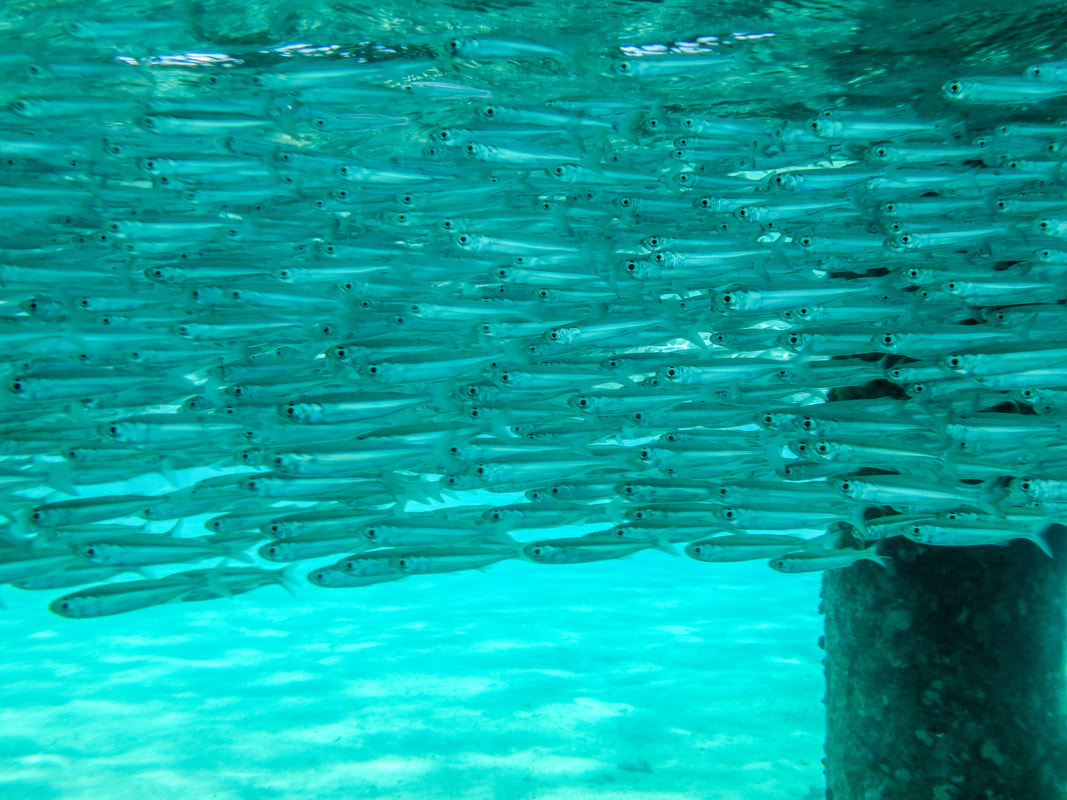
The best part was that Jordan has not really monetized their reef location. There were kilometers of almost deserted public beach, complete with palapas for shade. Apart from a couple of hostels for diving groups, there was one paid-entrance beach club where most people opted to congregate around the pool or sunbathe.
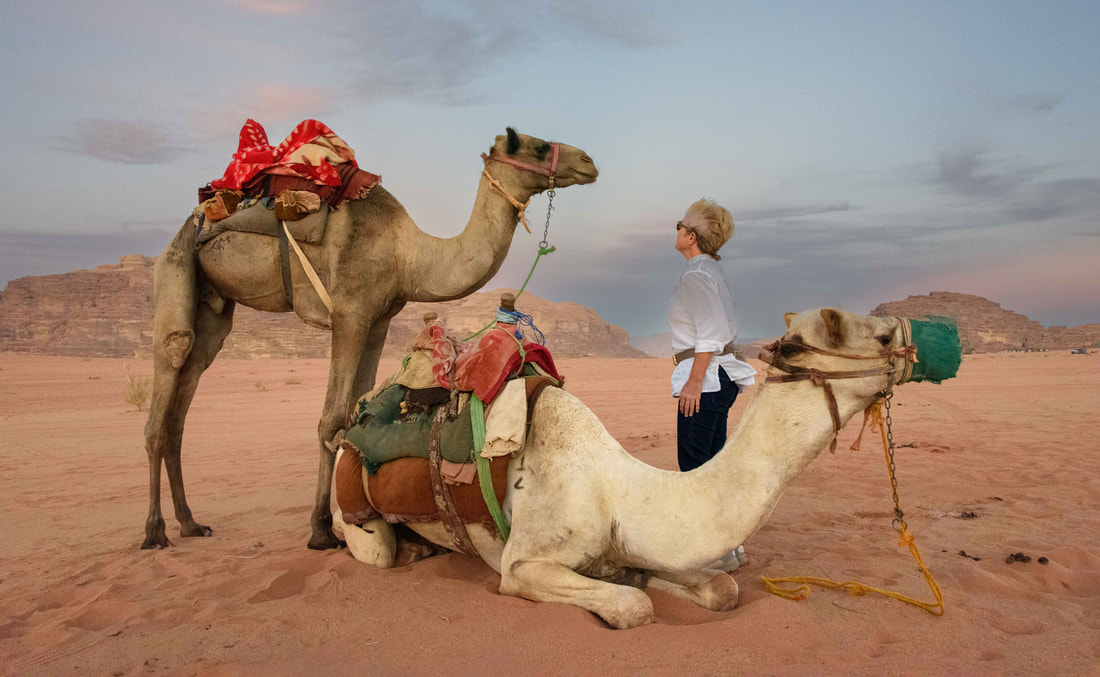
Our feelings about Wadi Rum were mixed and we weren’t prepared given the romanticized version of the area noted in our trusty guidebook. The landscape retains its beauty, but the cost of tourism has been high. Fifteen years ago, there were only a handful of tourist camps and those were reached by camels. This meant they were only a short distance into the desert leaving the rest of it to the traditional Bedouin people. (Wadi Rum, Oct 12-14/22)
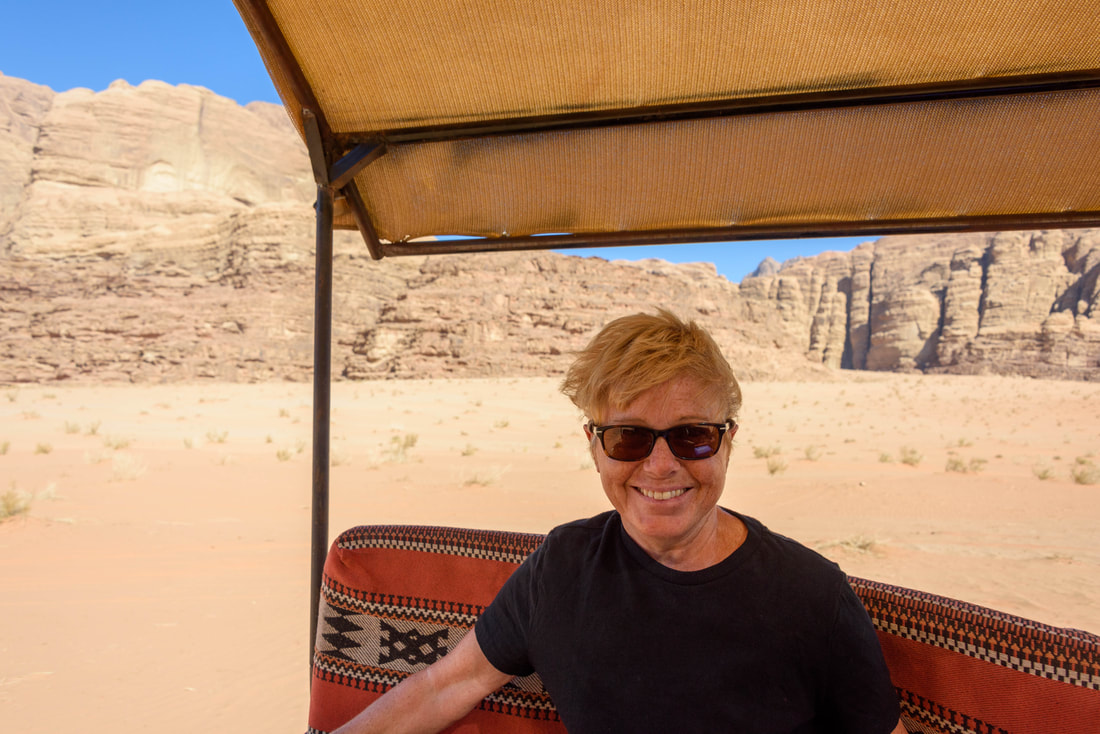
Most of the trucks were in dubious condition, helped along by the desert's harsh environment. Our driver/guide was intent on not being left in anyone’s dust. As we clung to anything available, we bounced around on cushion-covered metal benches in the flatbed while our driver careened around other drivers – it was exhausting, and we broke out laughing at the comedy of it all.
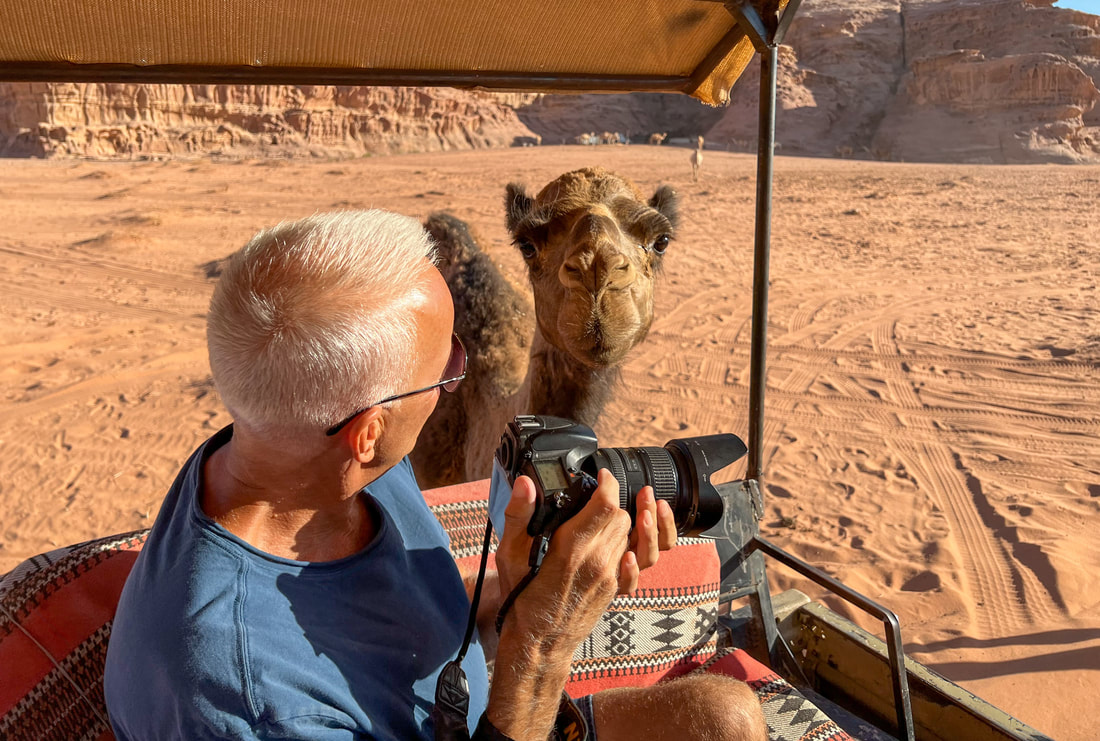
Rick noticed a large group of loose camels, so he asked the driver to stop. I guess some of the tourists feed them because suddenly a group of 3 bolted surprisingly fast toward our truck. I panicked and jumped back to the furthest reach of our cab while Rick took pics of the other 2, not realizing this guy was right behind him. It was actually a little unnerving as they stuck their heads inside our space looking for something.
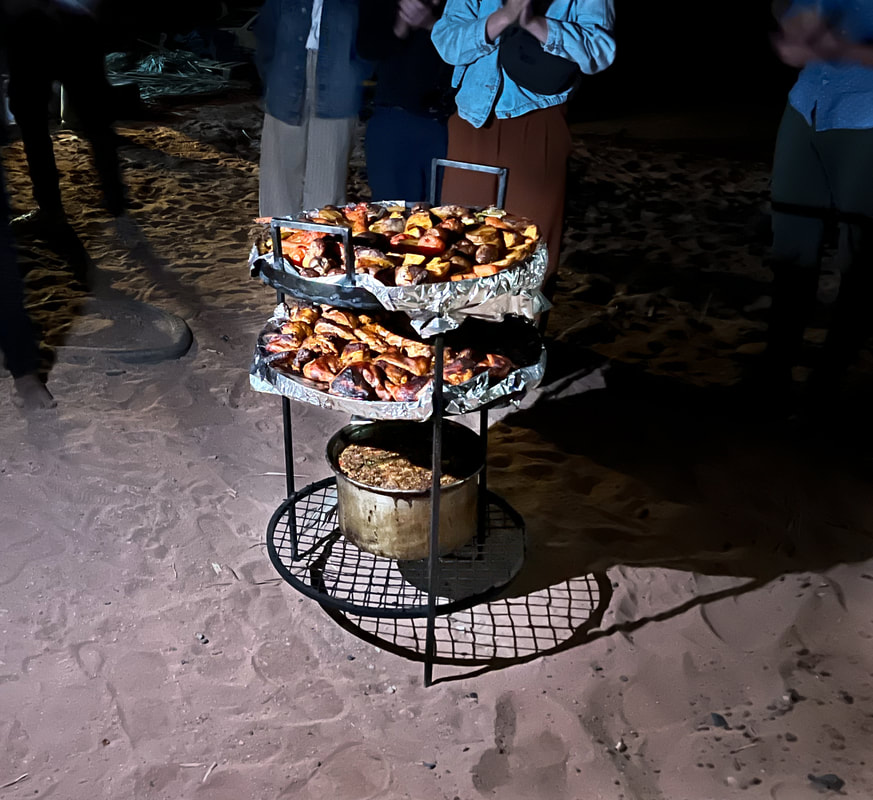
Back at camp, dinner was a traditional zerb - a meal cooked in the ground. The non-traditional twist was the 3-part tray that fit perfectly into the chef’s metal hole in the sand. Covered with a lid, then tinfoil, then blankets and topped off with a few shovelfuls of sand, the food slow cooked for a few hours.
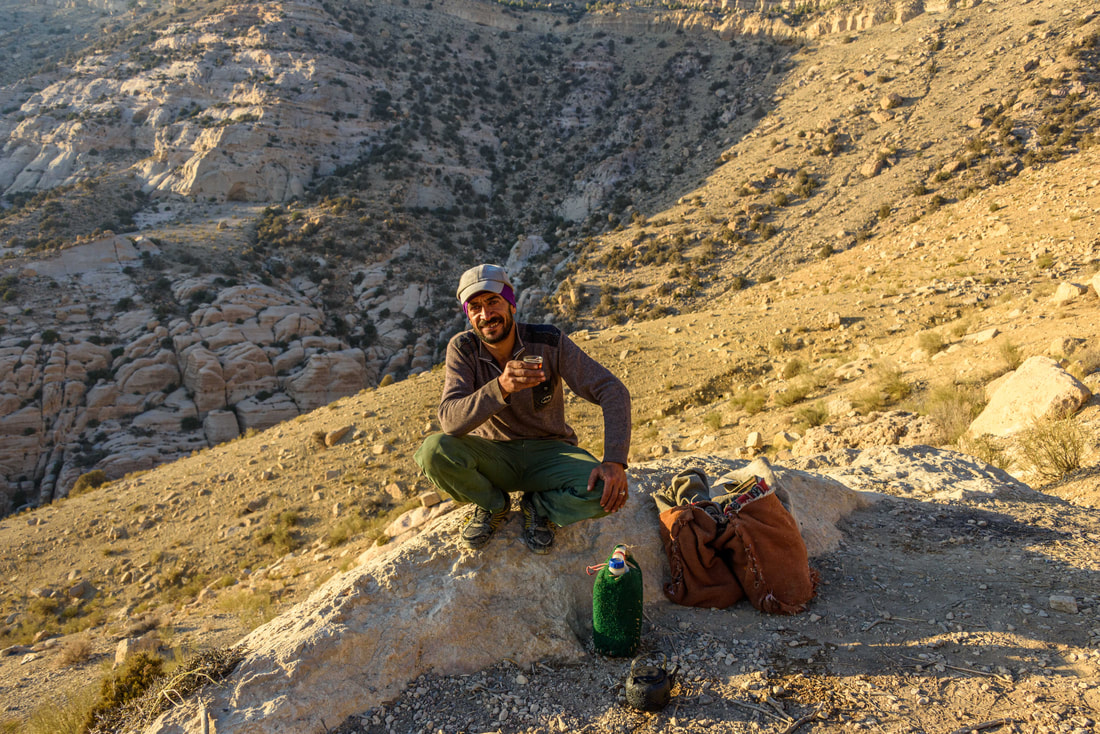
The Dana Biosphere Reserve ranges between -45m below sea level to 1,700m above. It’s a protected area for the flora and fauna that it supports, but the goat and sheep appear to be accepted guests. While going for a short hike we ran into a couple of shepherds who had the best view. While one was doing most of the work the other played host to us. When we declined his offer of tea, he insisted on taking a bunch of photos of us, including carefully placing the teapot and cups so that they were part of the shots. In return he went into model mode for us to take a pic of him. As we headed off, he saw me sliding on the loose soil, so he made me a walking stick. With no money expected, it was a welcome display of hospitality. (Dana, Oct 15-16/22)
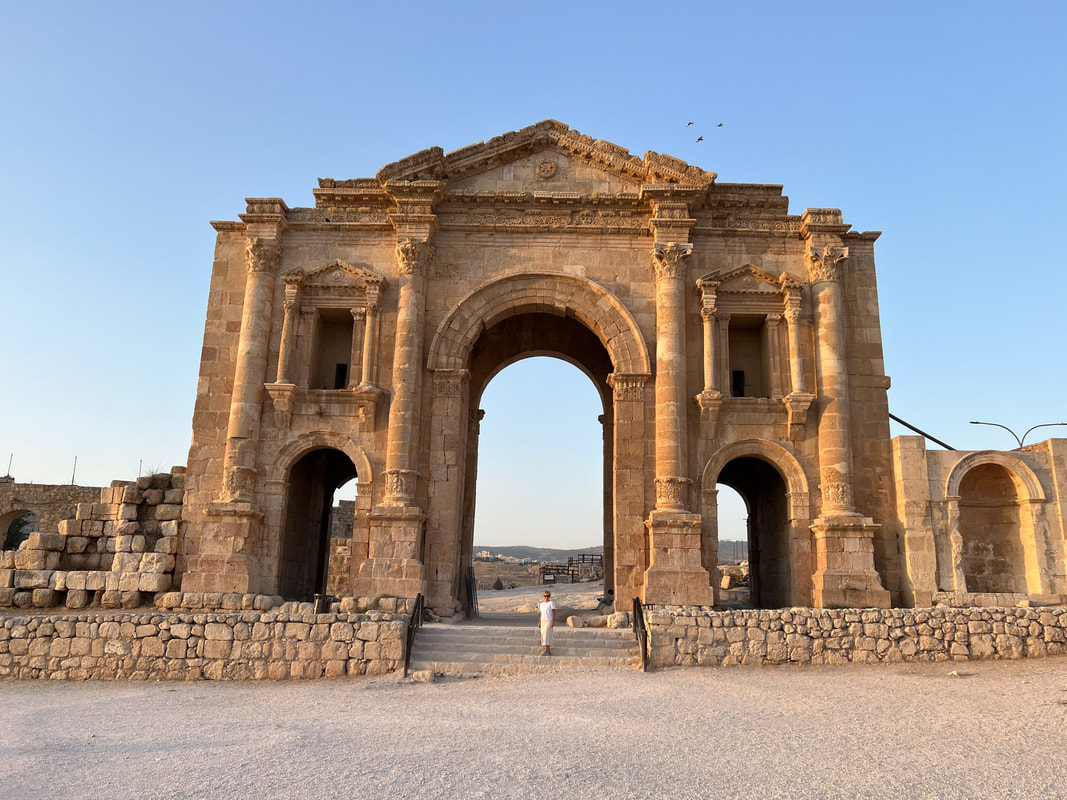
Jerash boasts well preserved Roman ruins, second only to those in Italy. Hadrian’s Arch was built for the Emperor Hadrian in AD 129. As with so many ancient structures the sheer scale is daunting, leaving us specks in photos. Above: At the end of the day, the setting sun gave the stone a warm golden tone and everyone was gone. (Jerash, Oct 17-19/22)
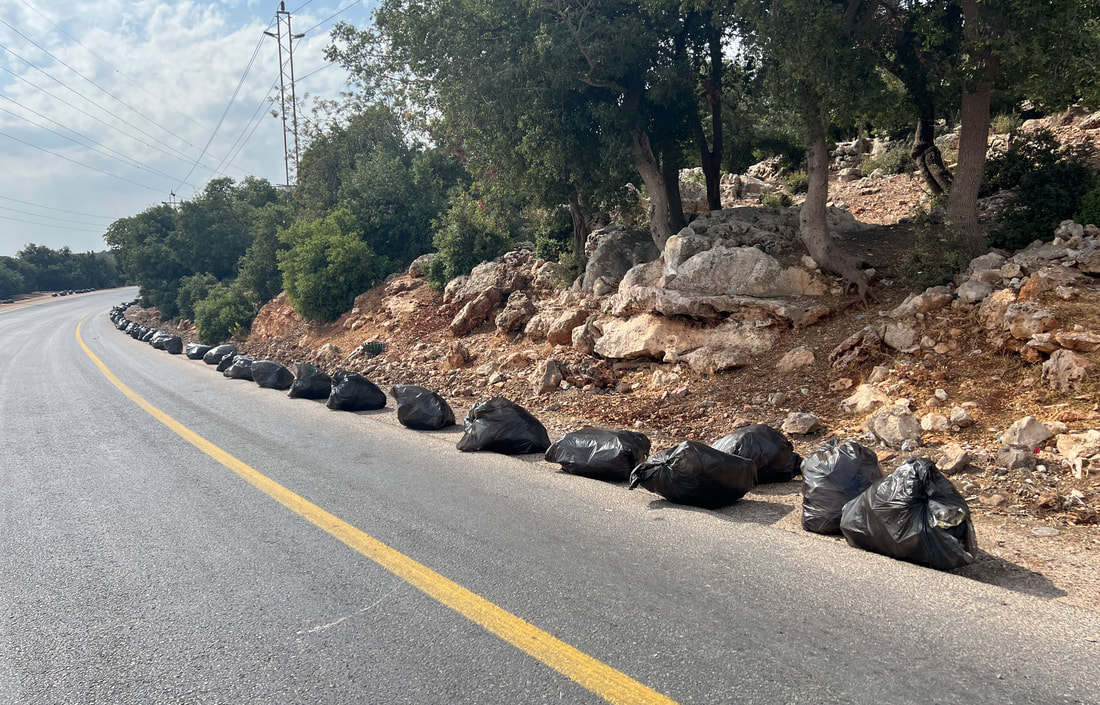
The daily sight of garbage everywhere, except in the center of tourist areas, has become wearing. According to news articles, the man on the street's attitude is that it’s ok to throw your garbage bags, bottles, wrappers, etc somewhere outside your own home or business. It’s someone else’s responsibility to clean it up. Two years ago the government instituted stiff fines and doubled them in parks and in tourist sites. Above: we’ve seen signs of cleanup activities and the density of black bags gives an idea of how much garbage there was.
